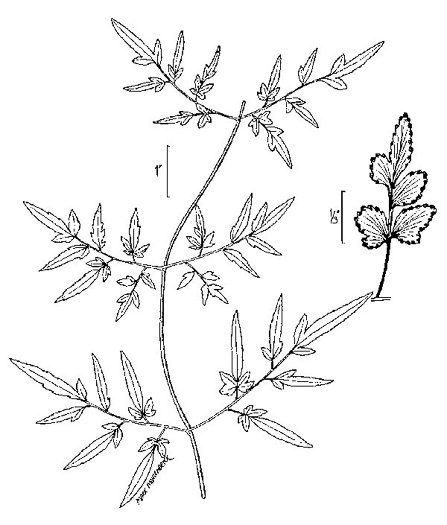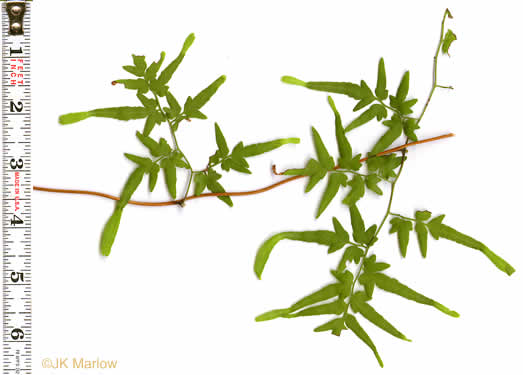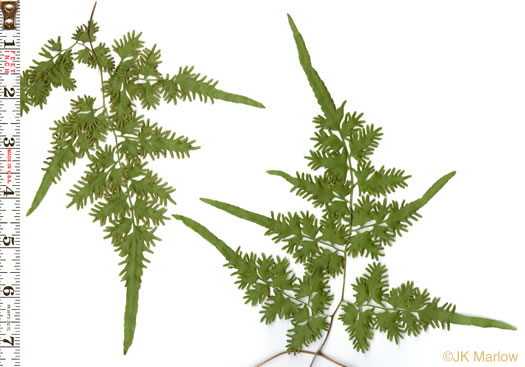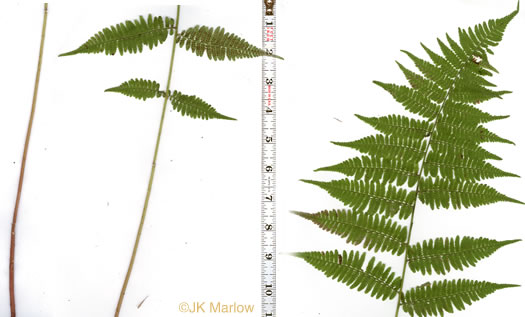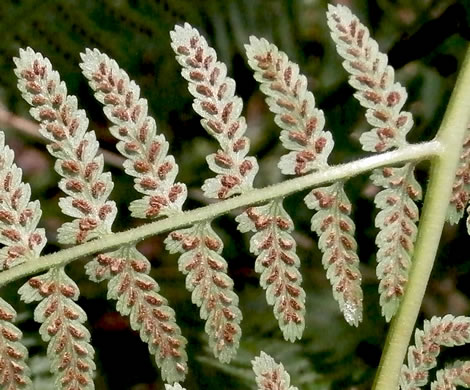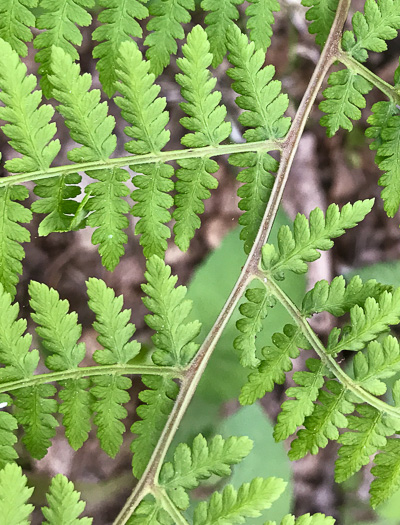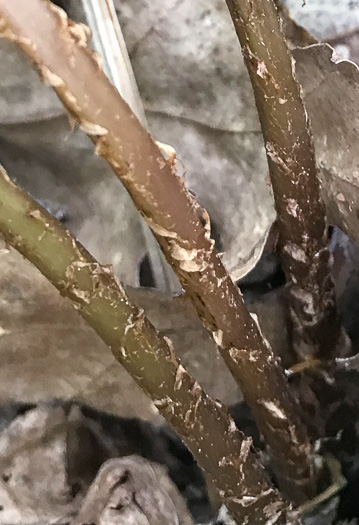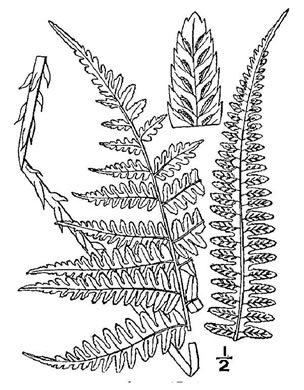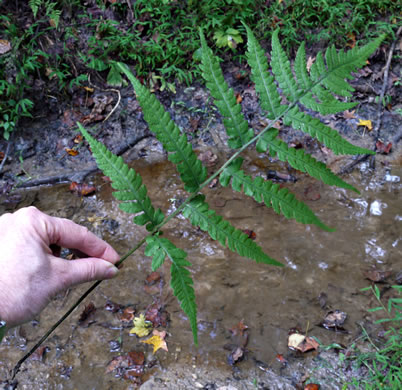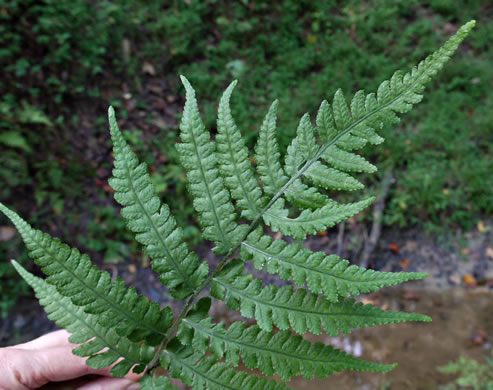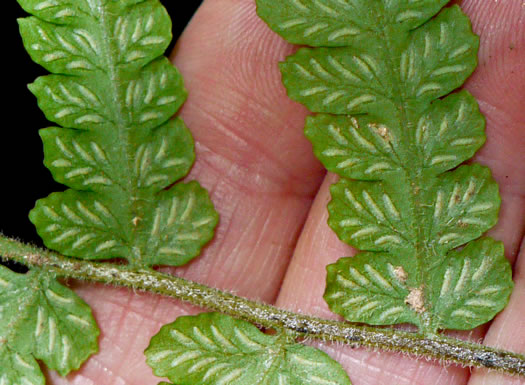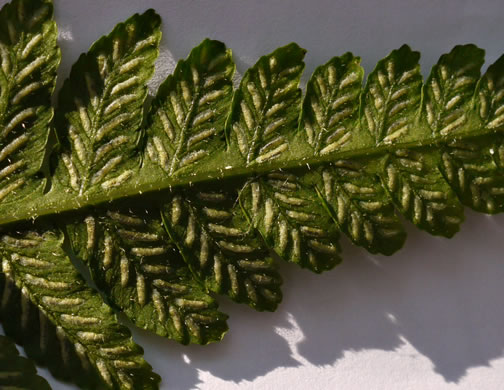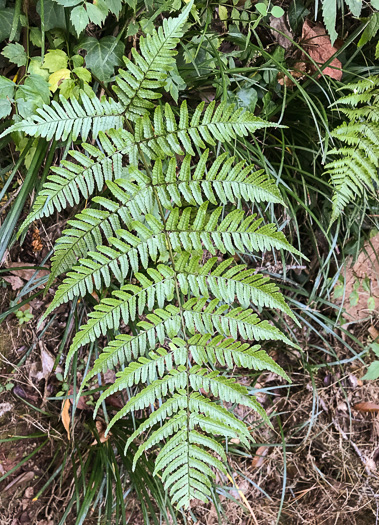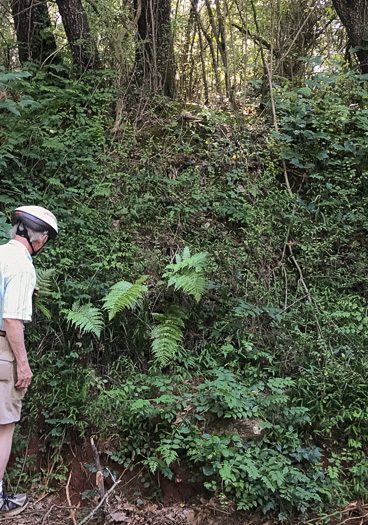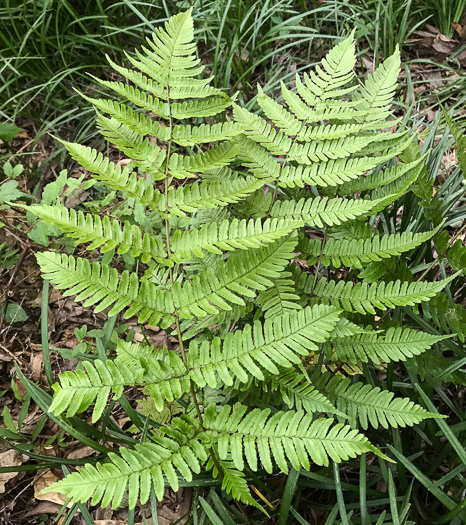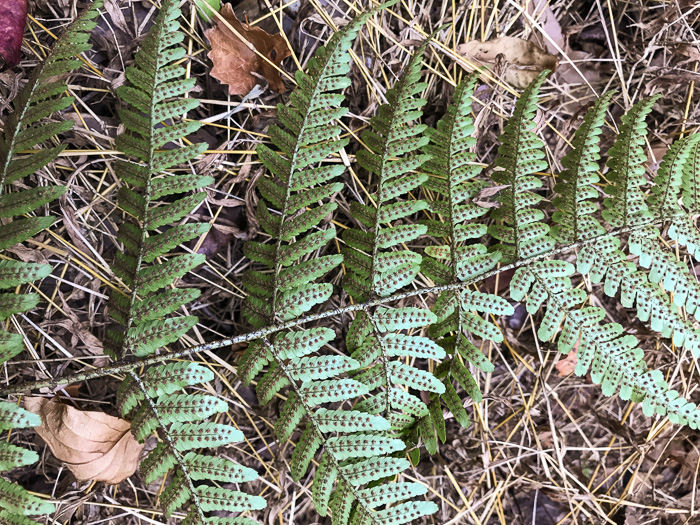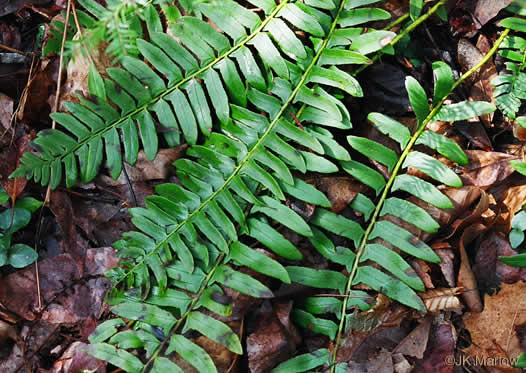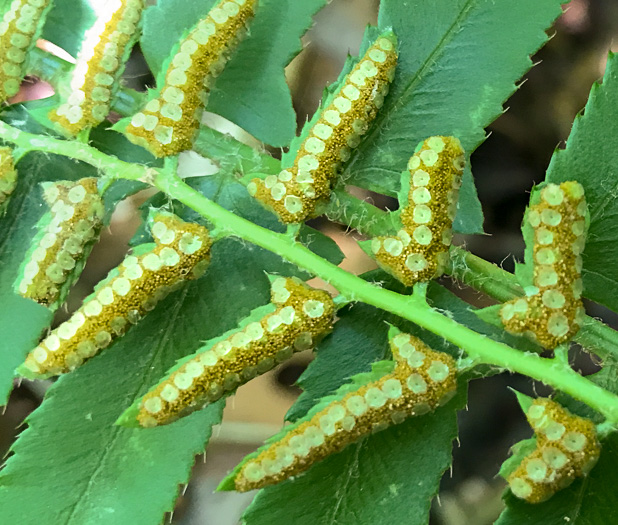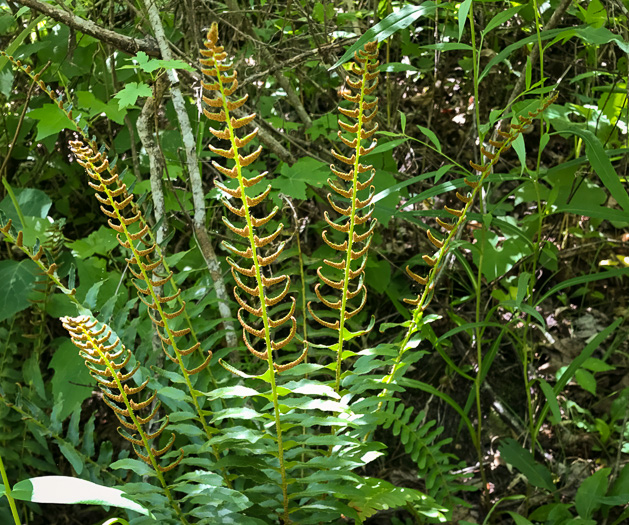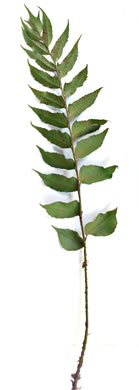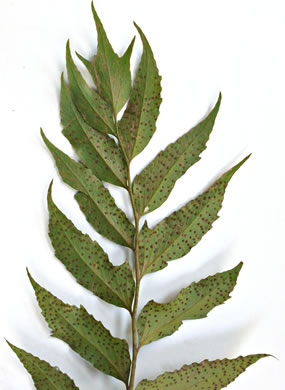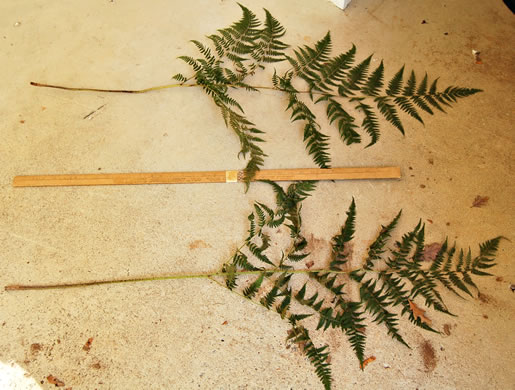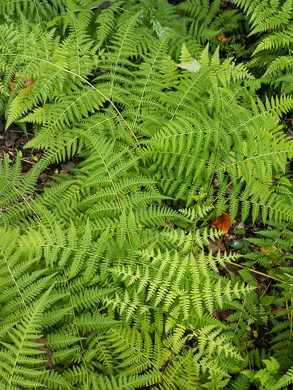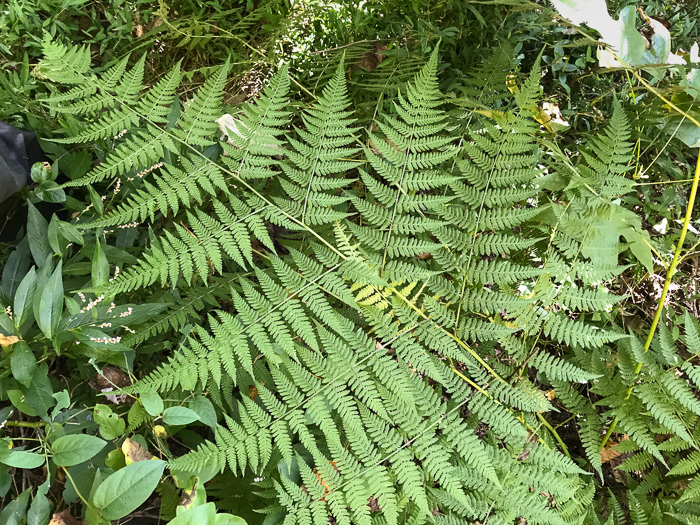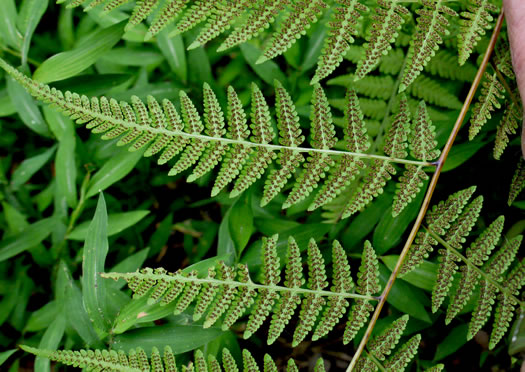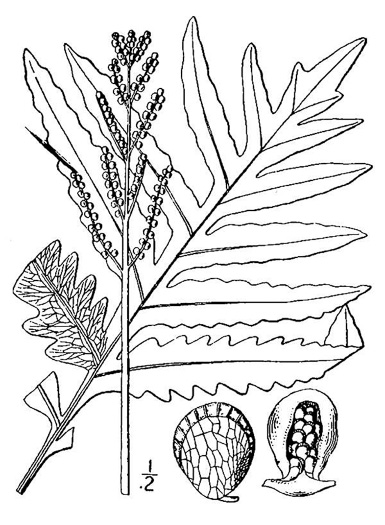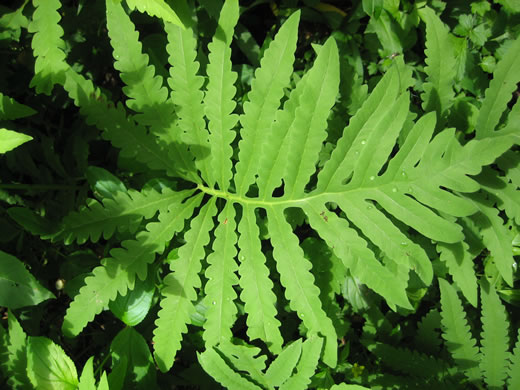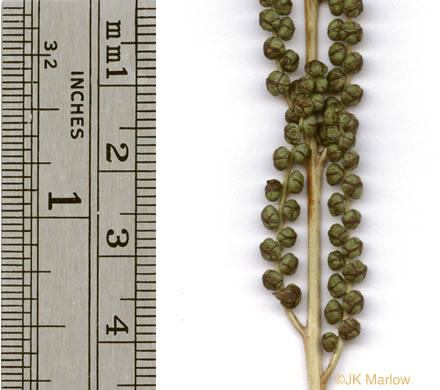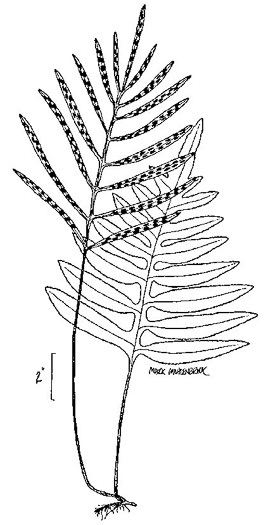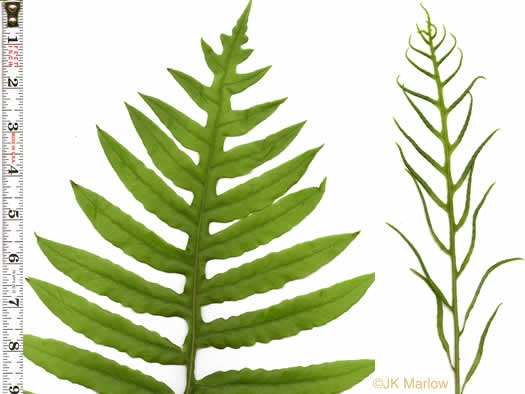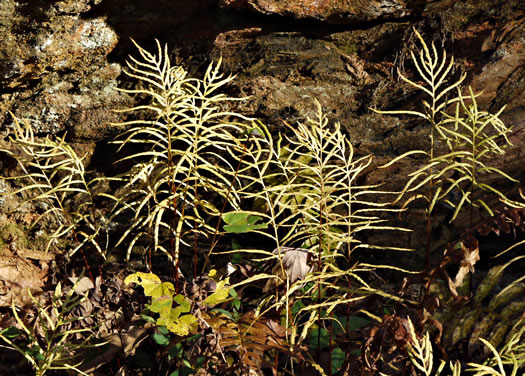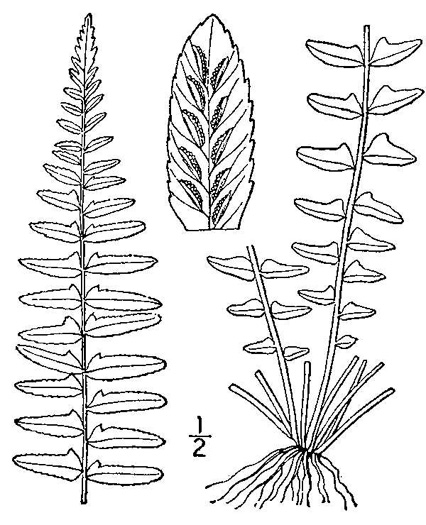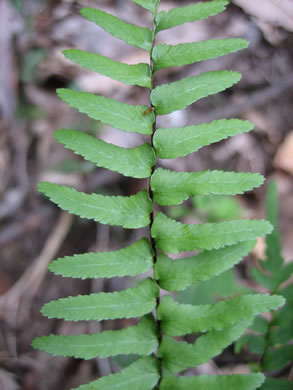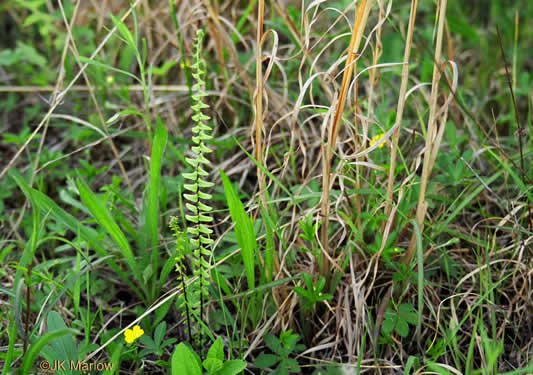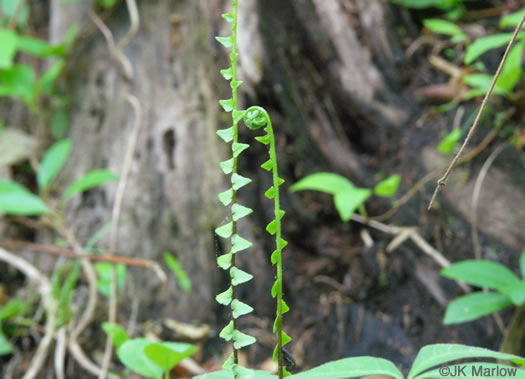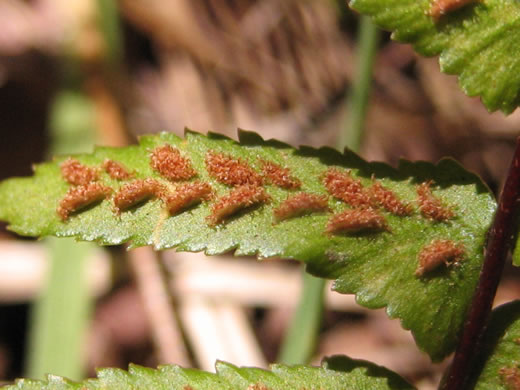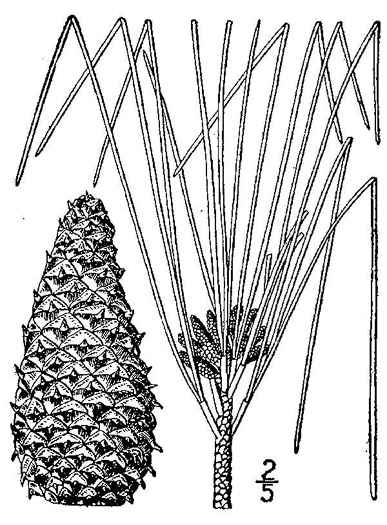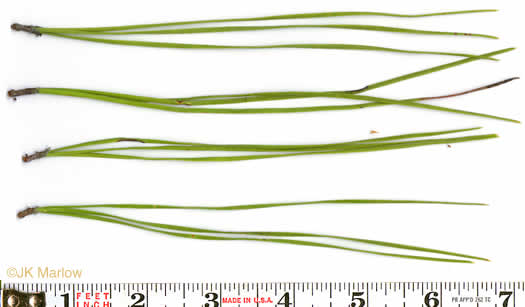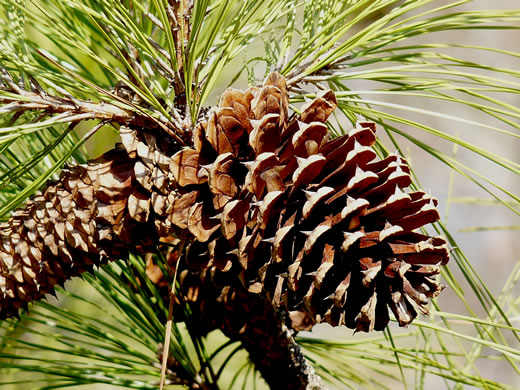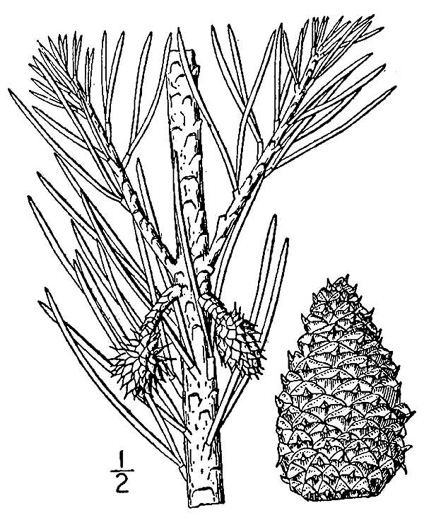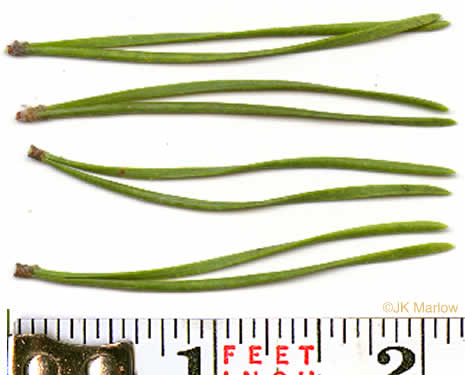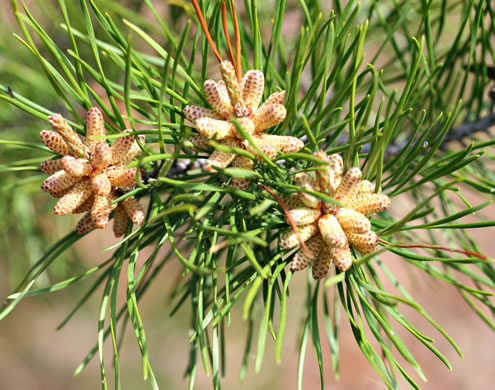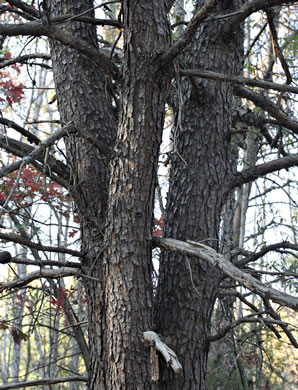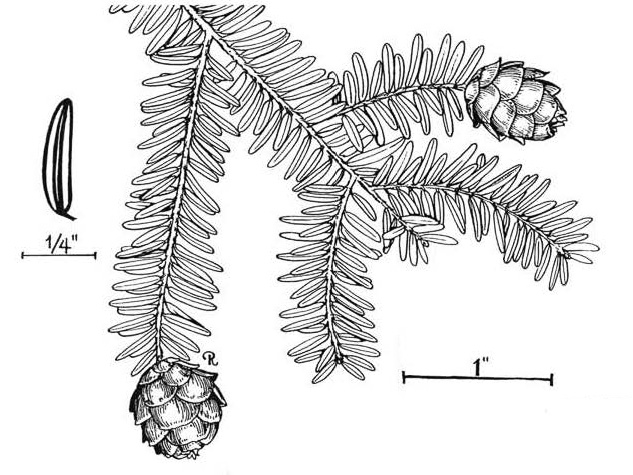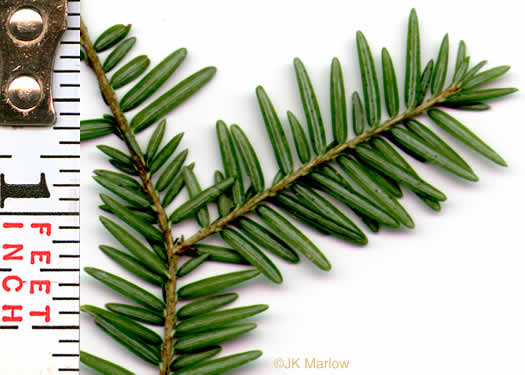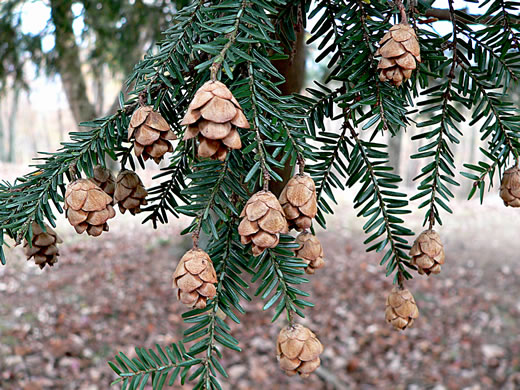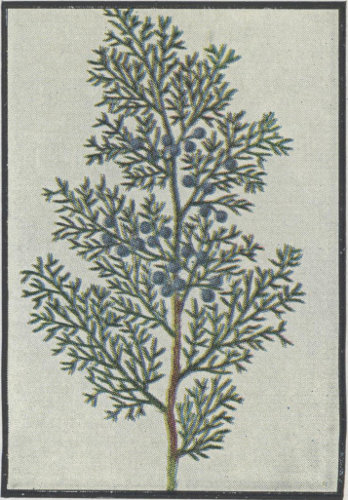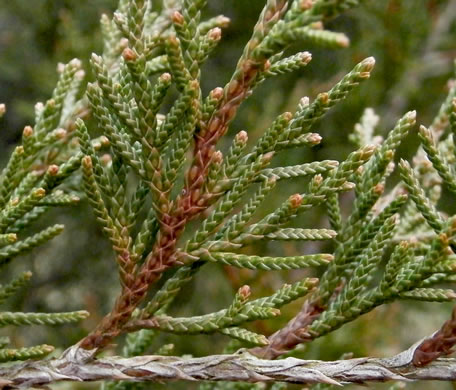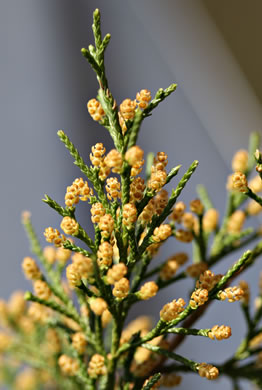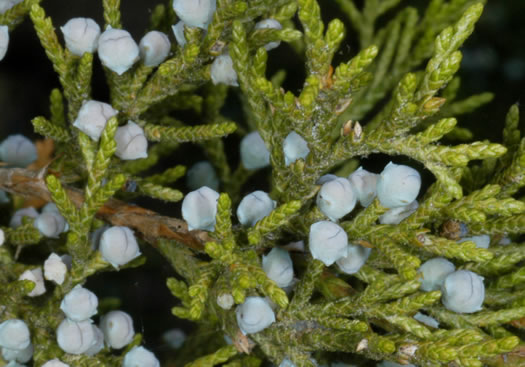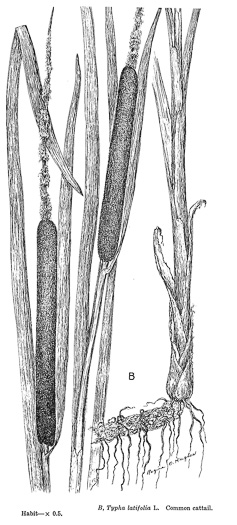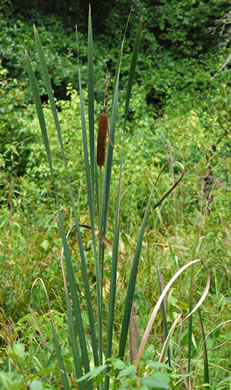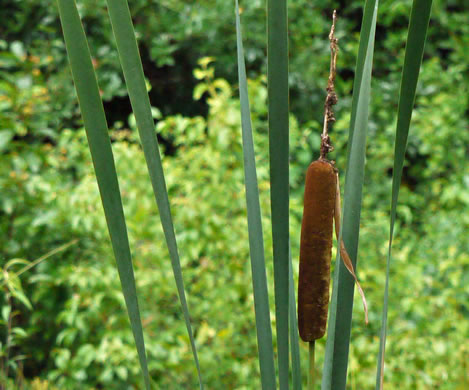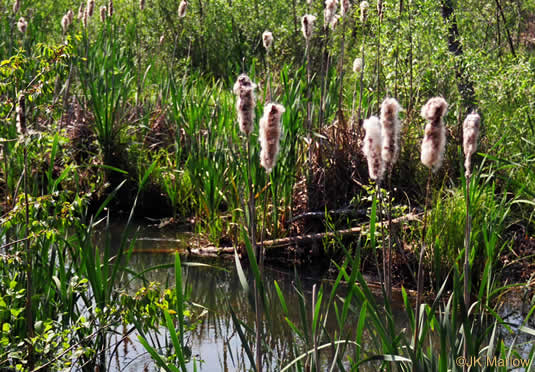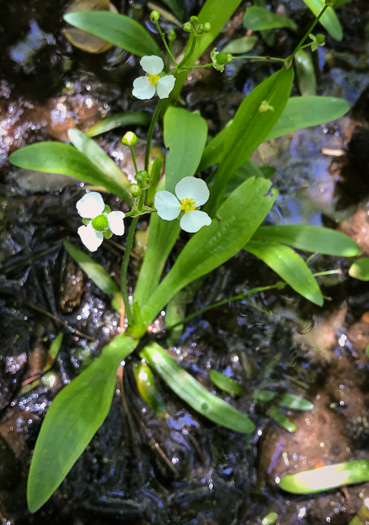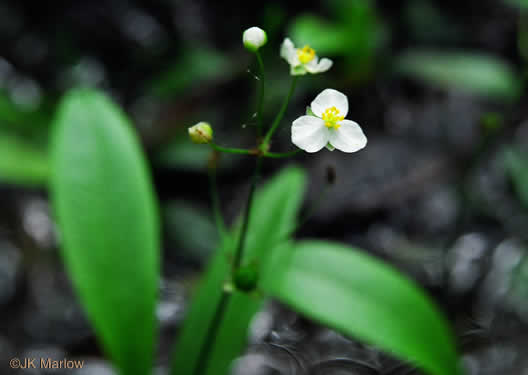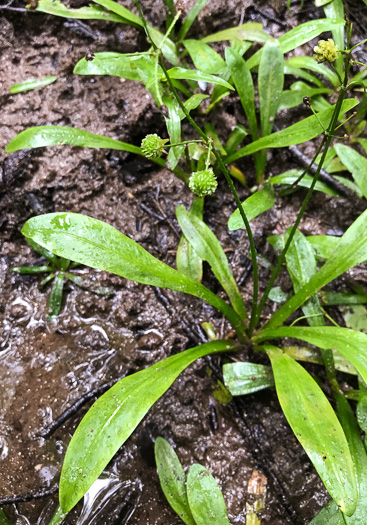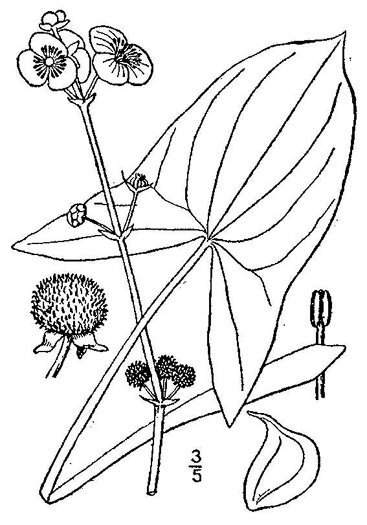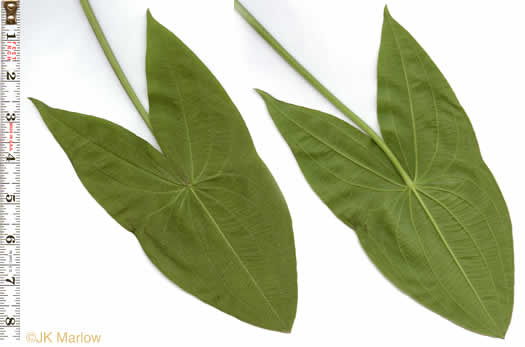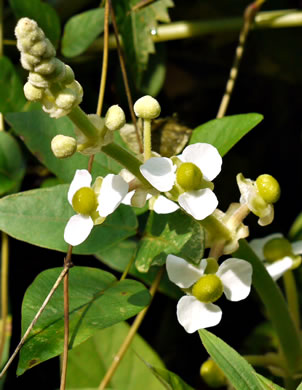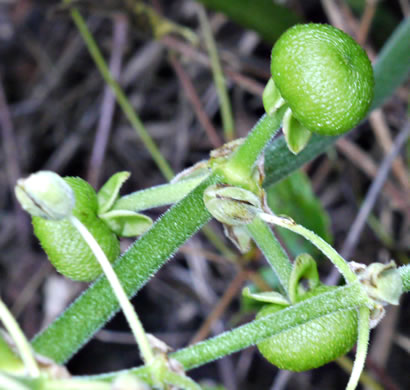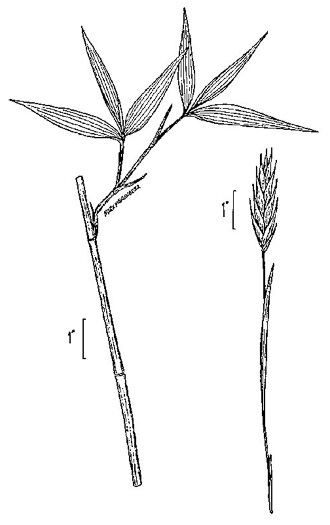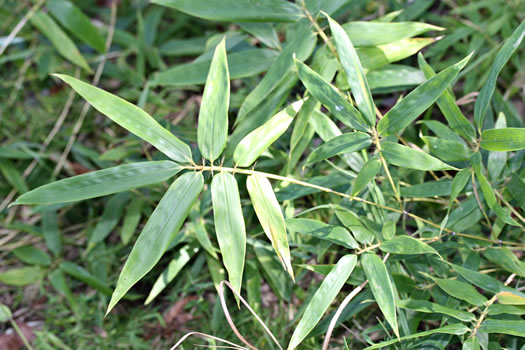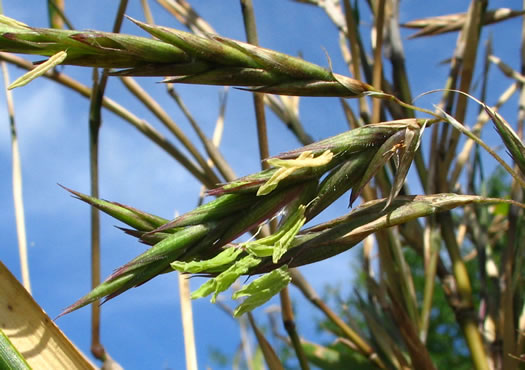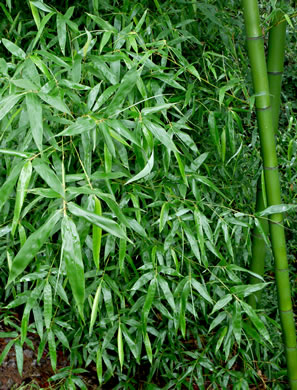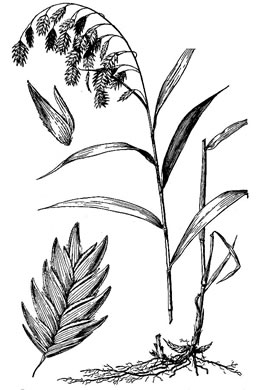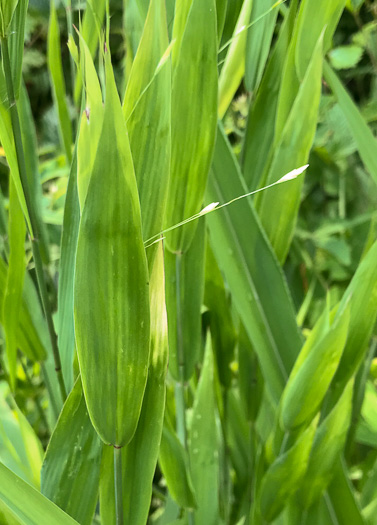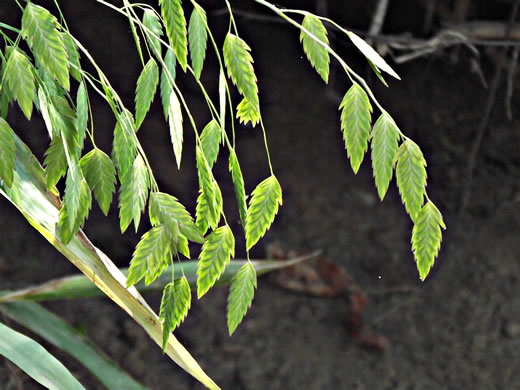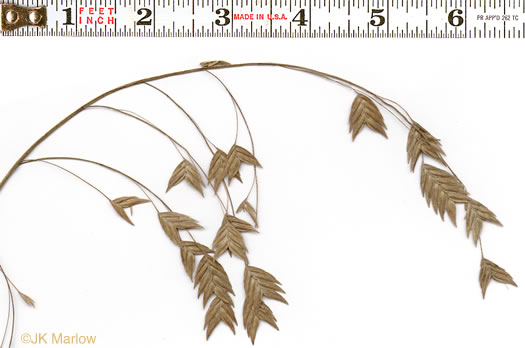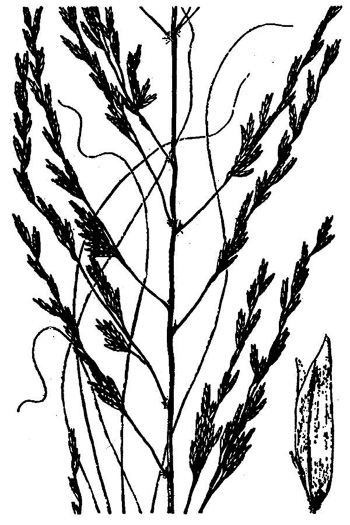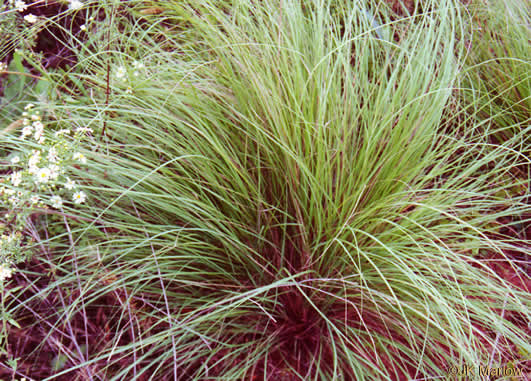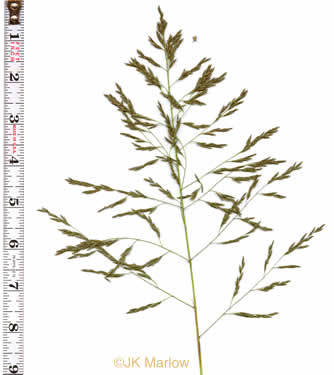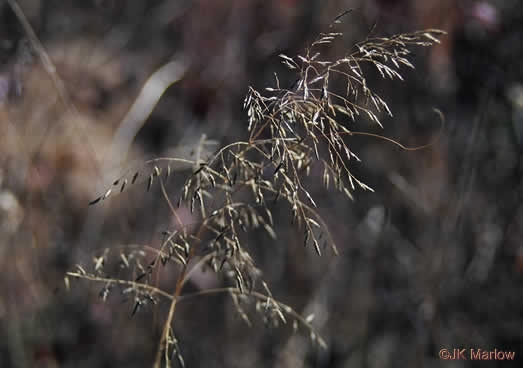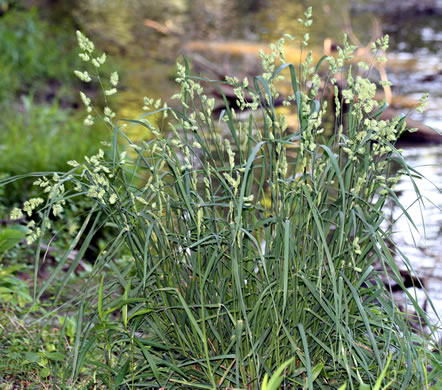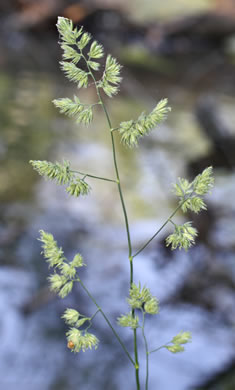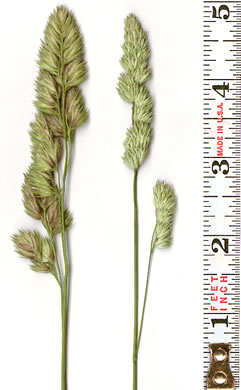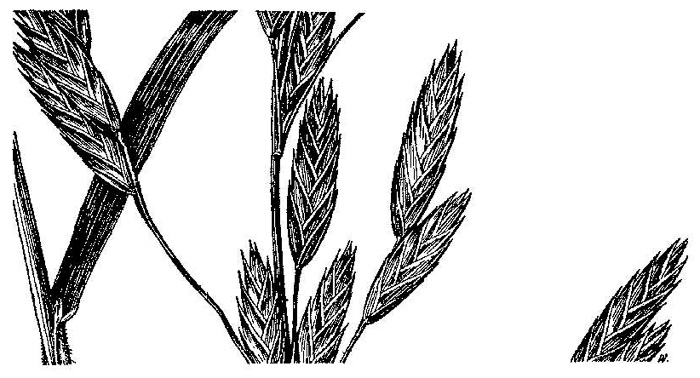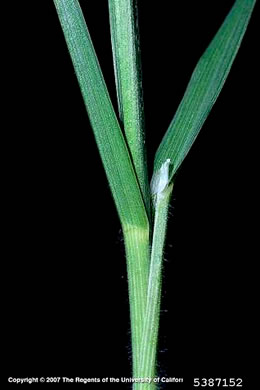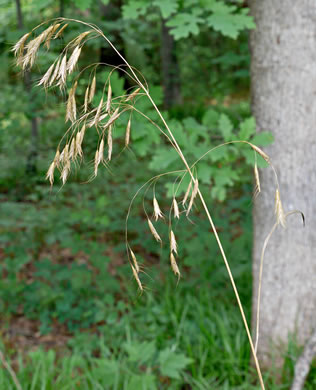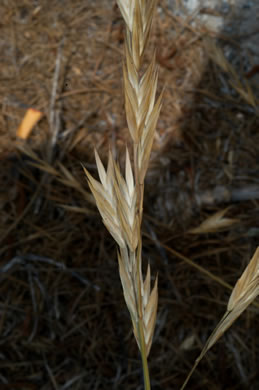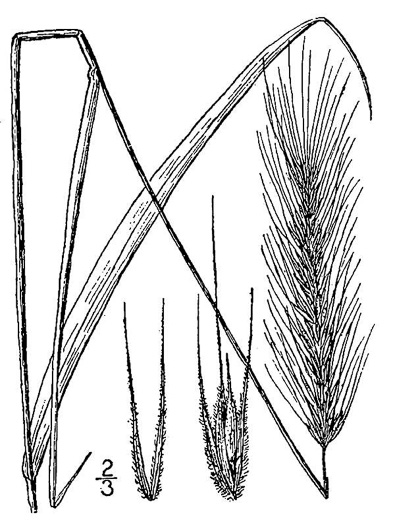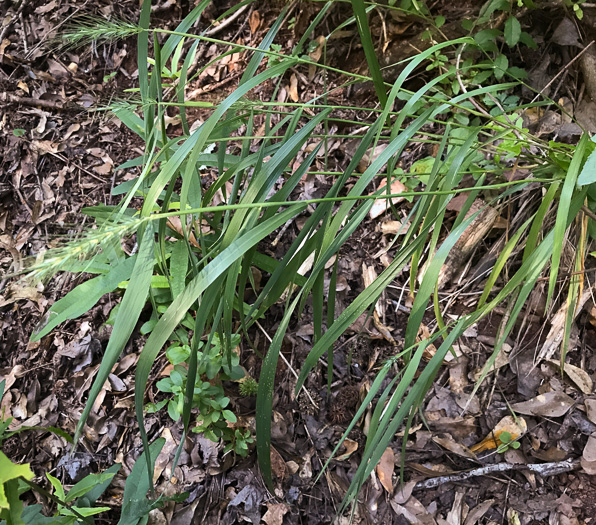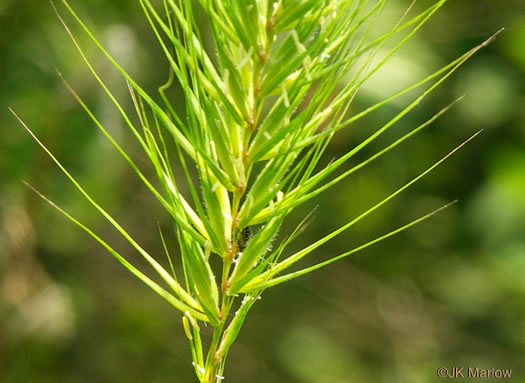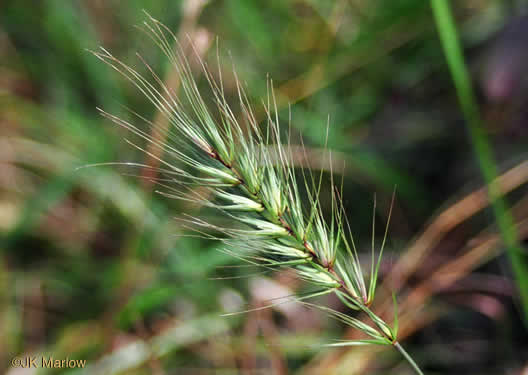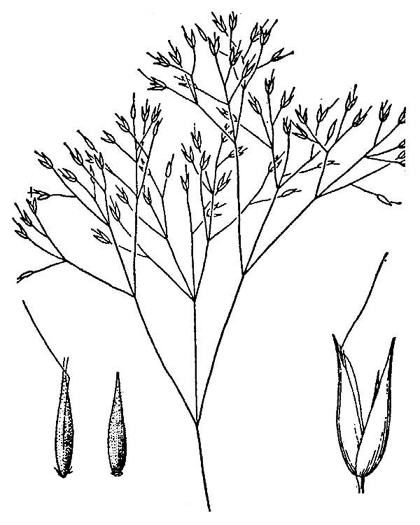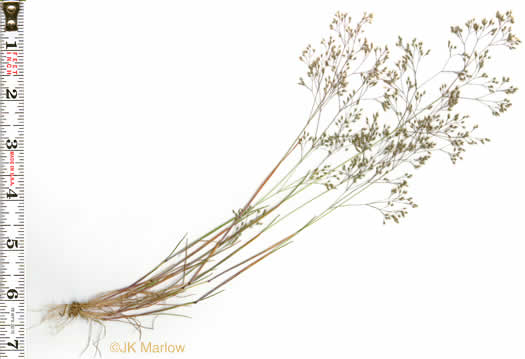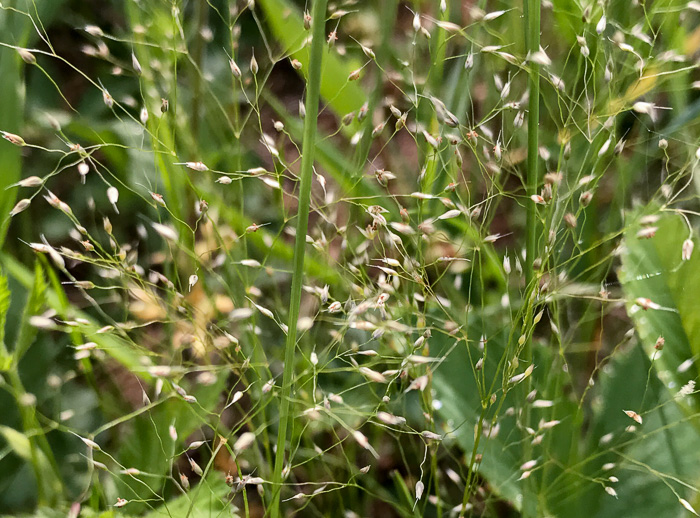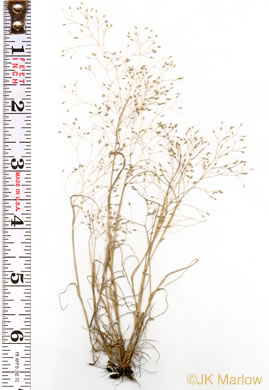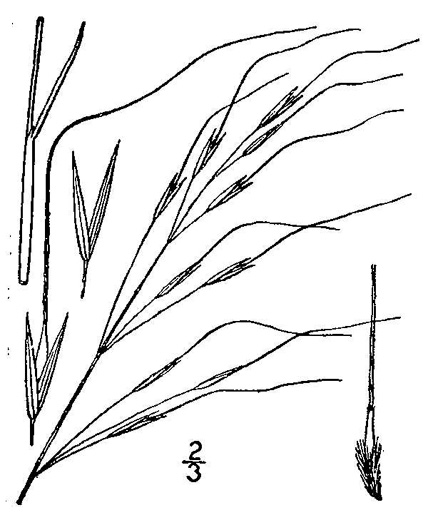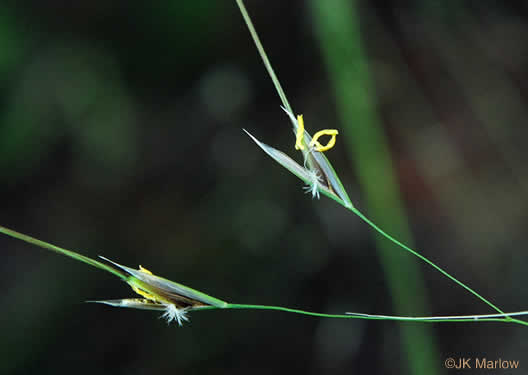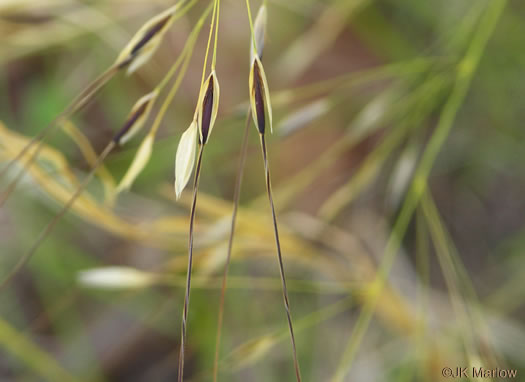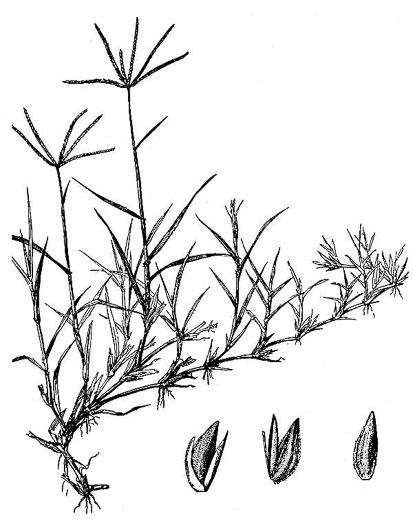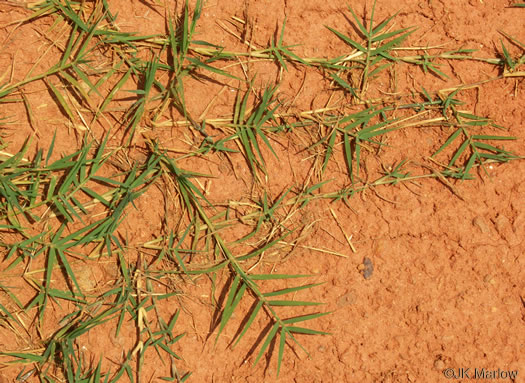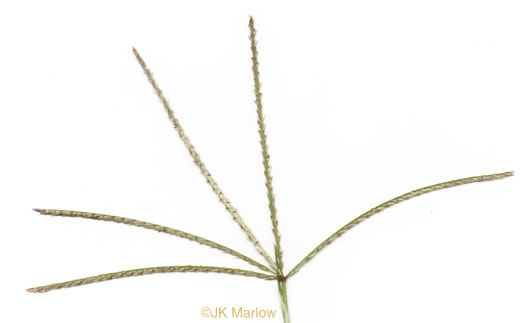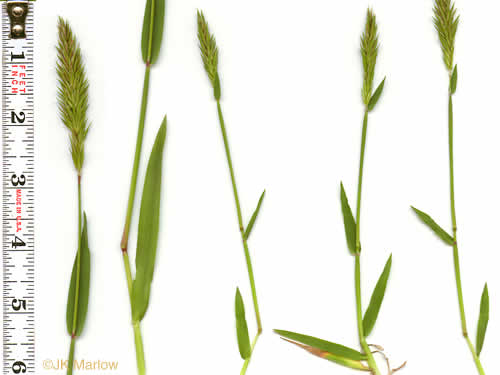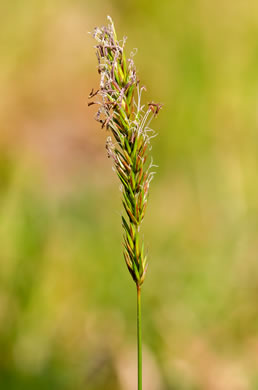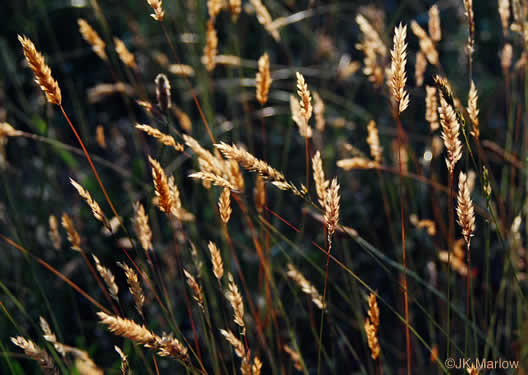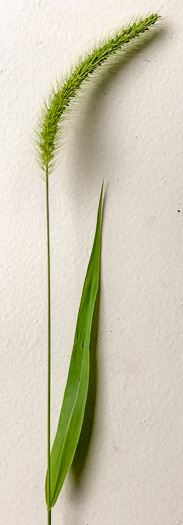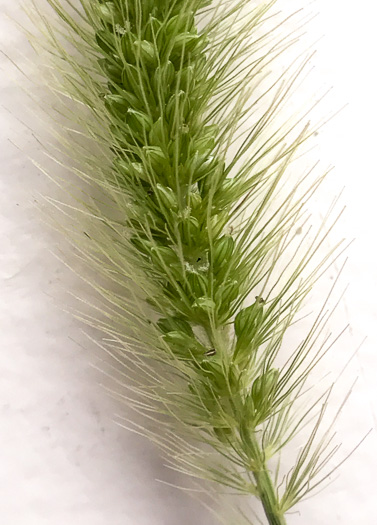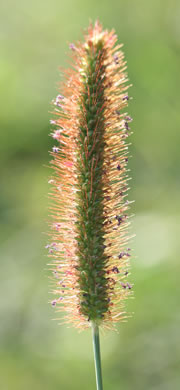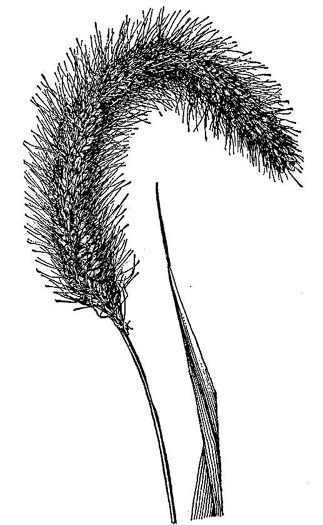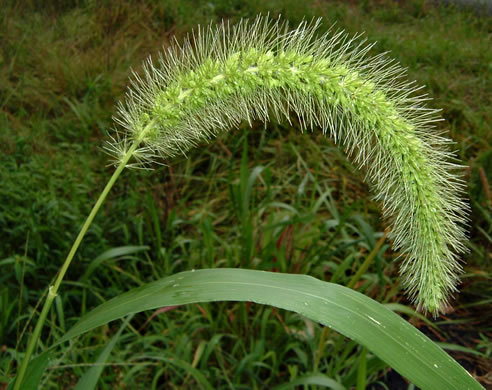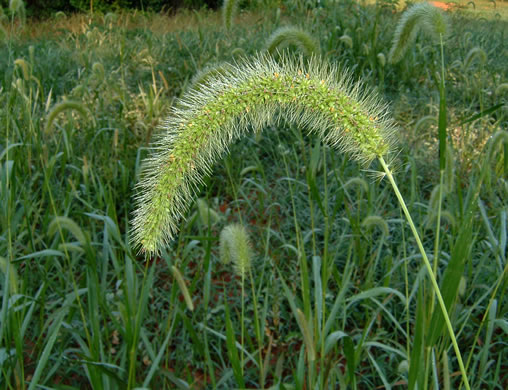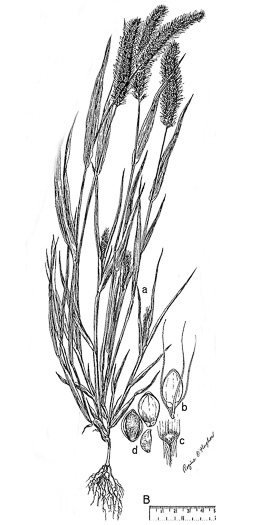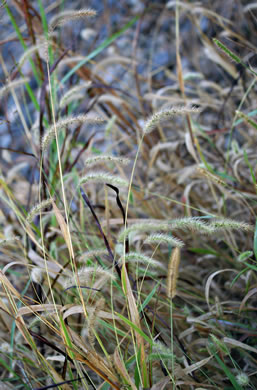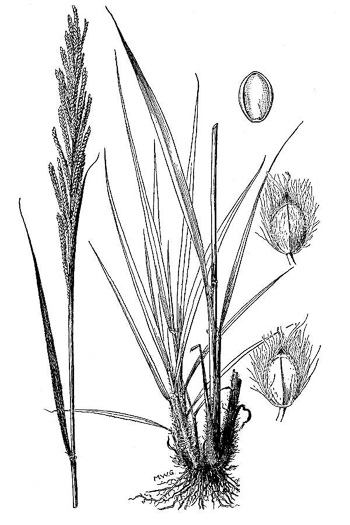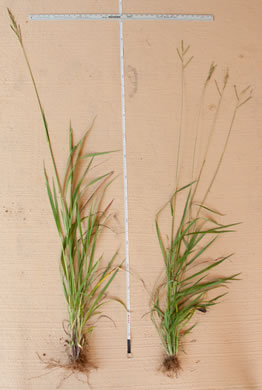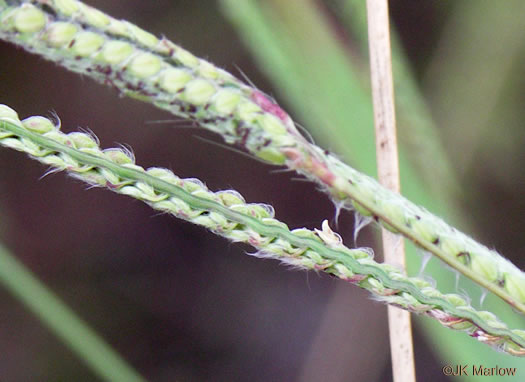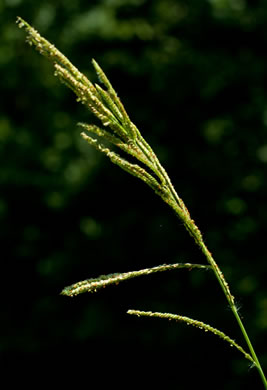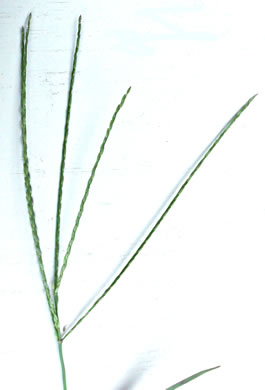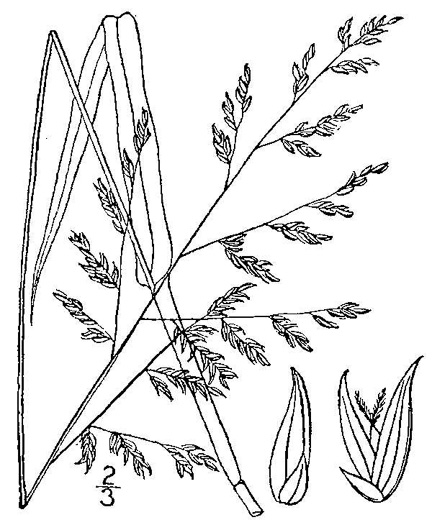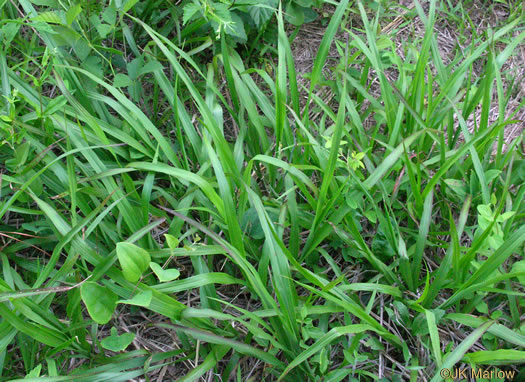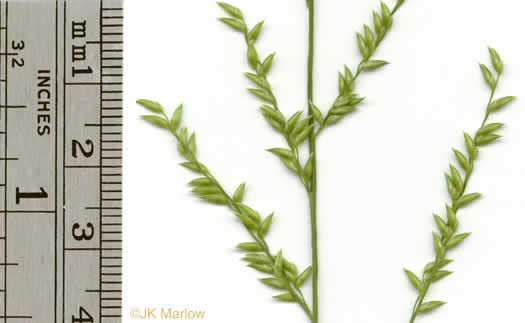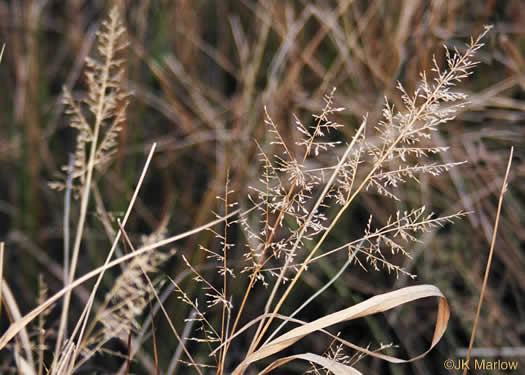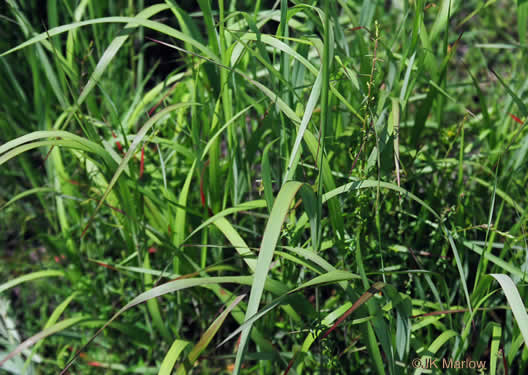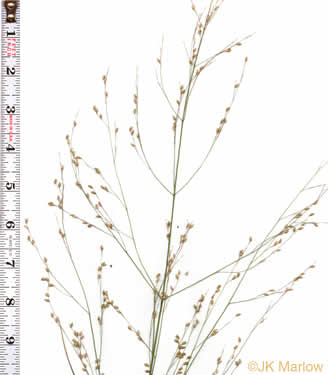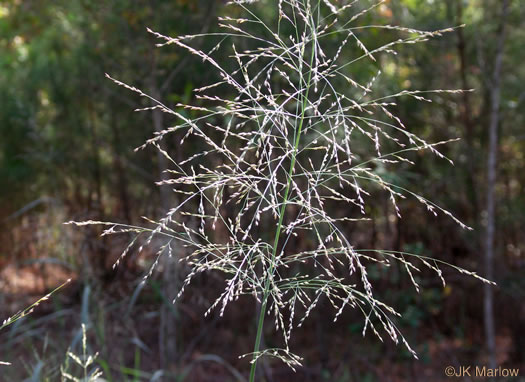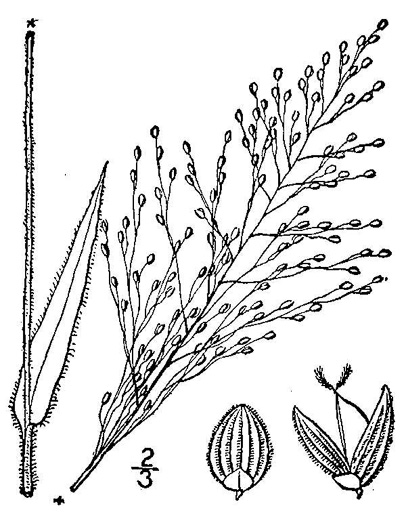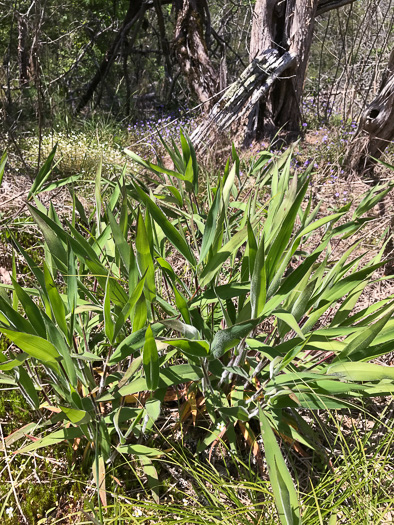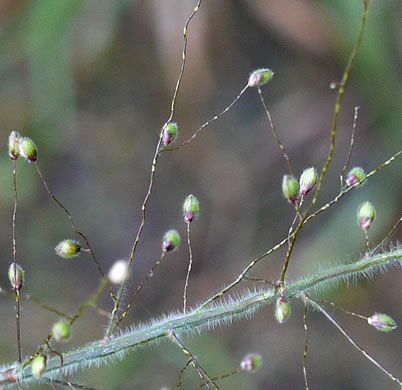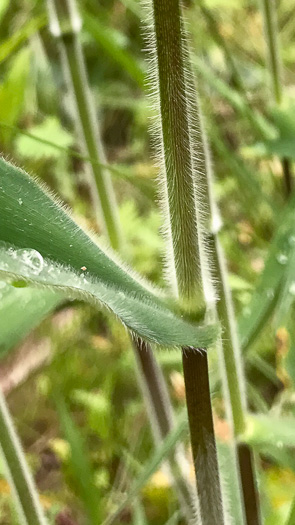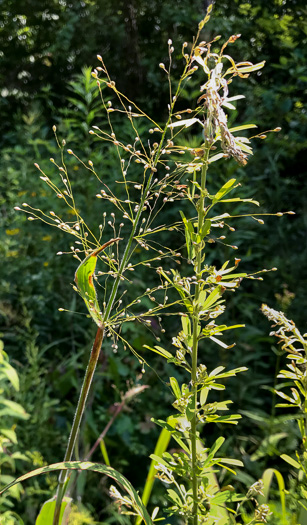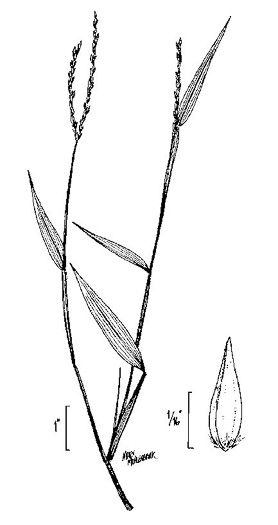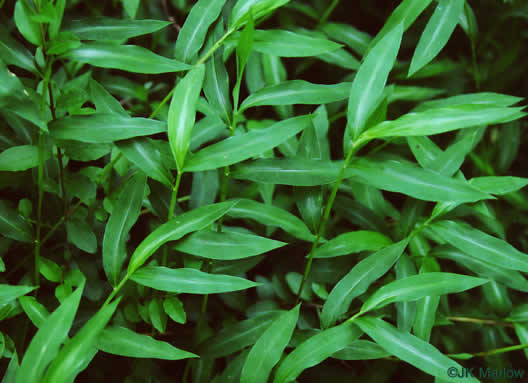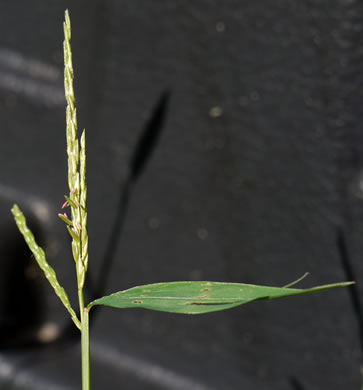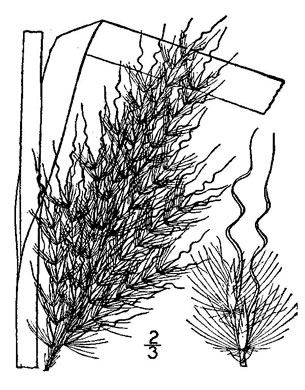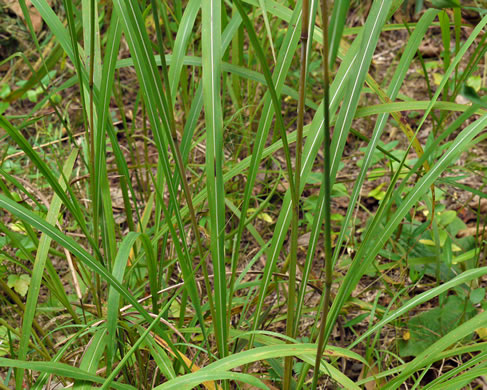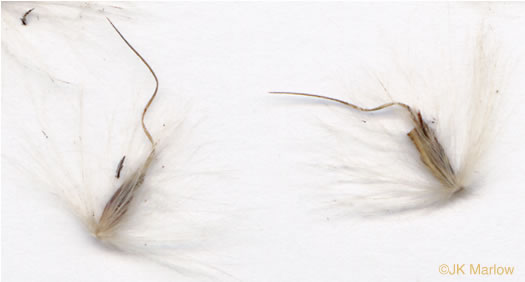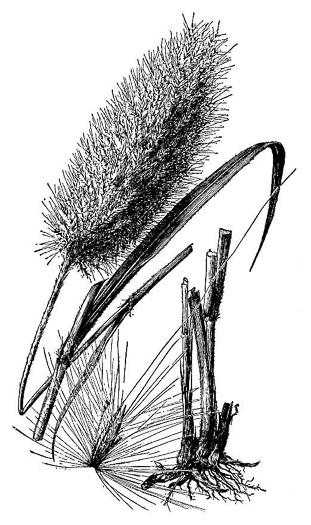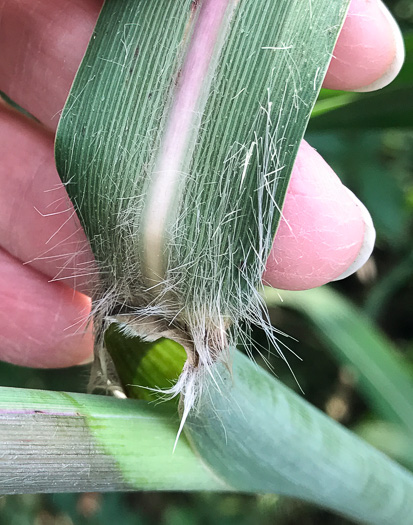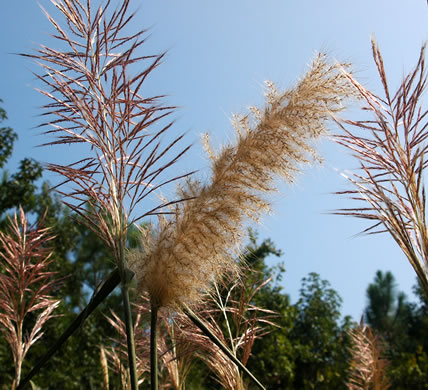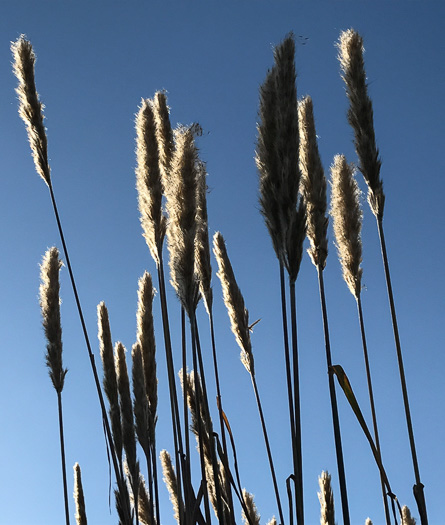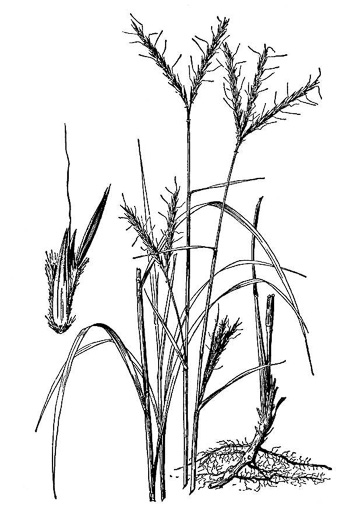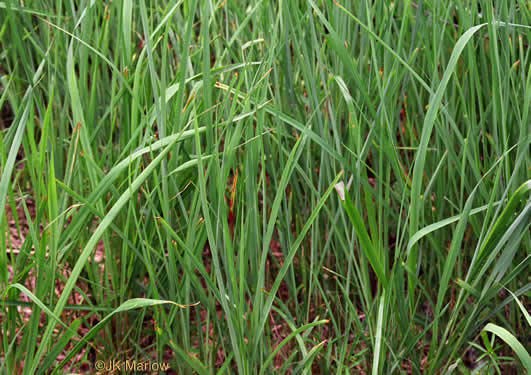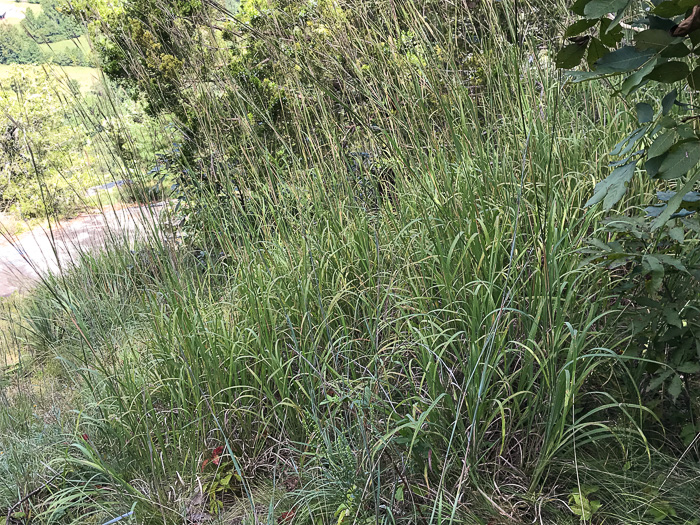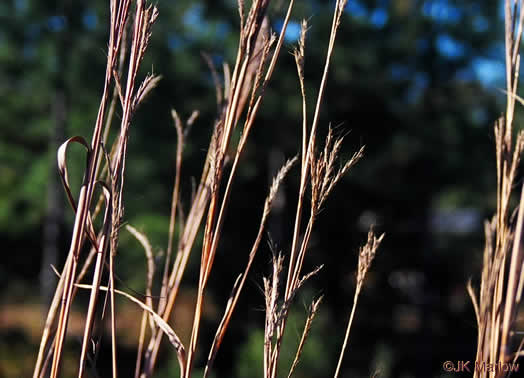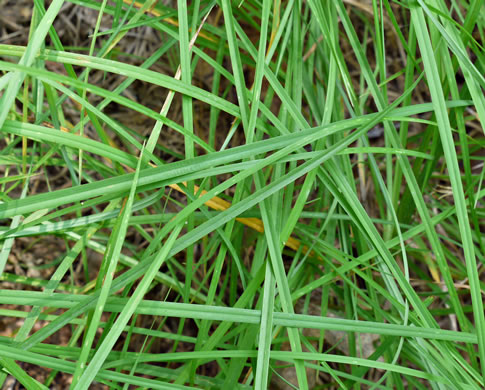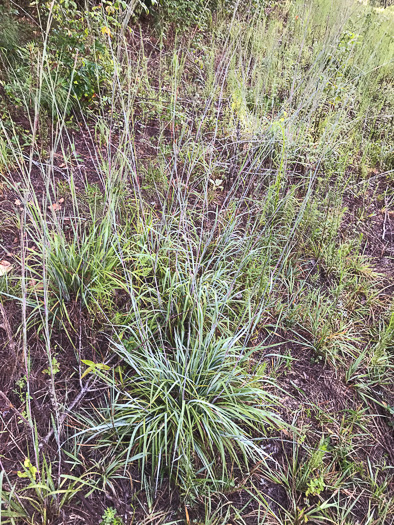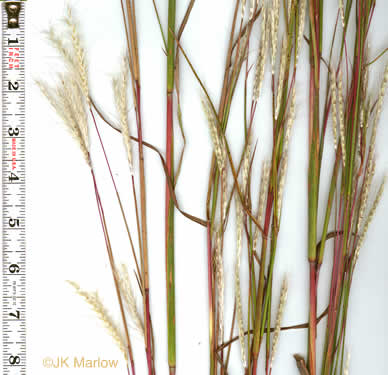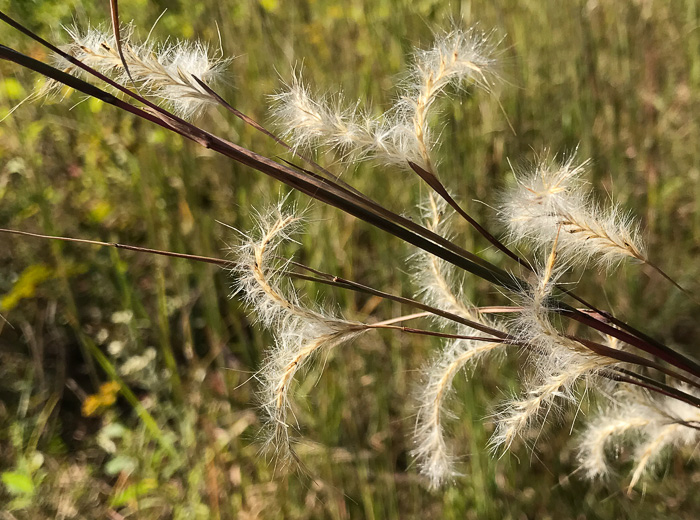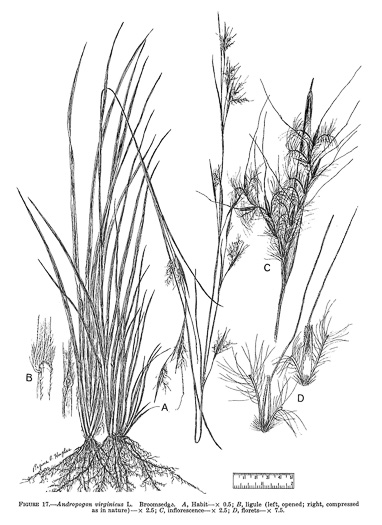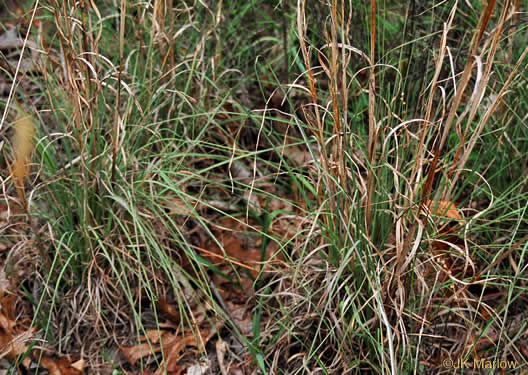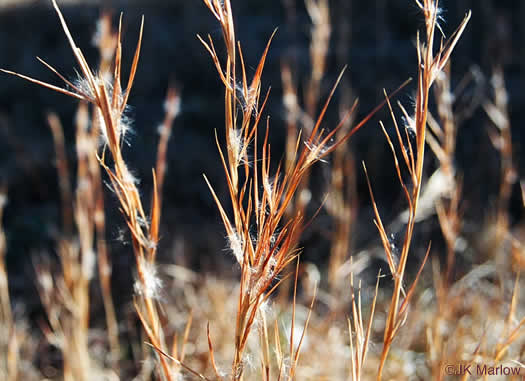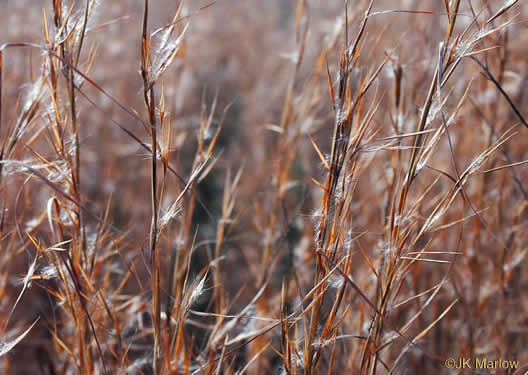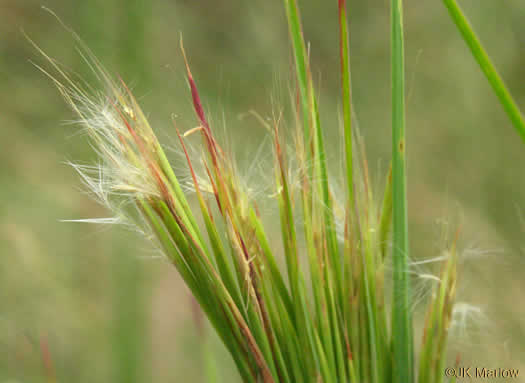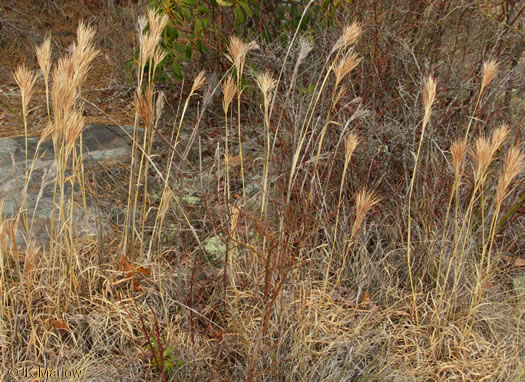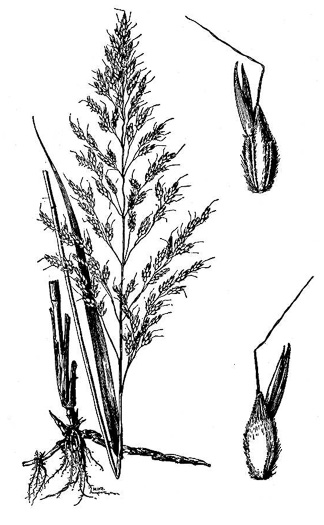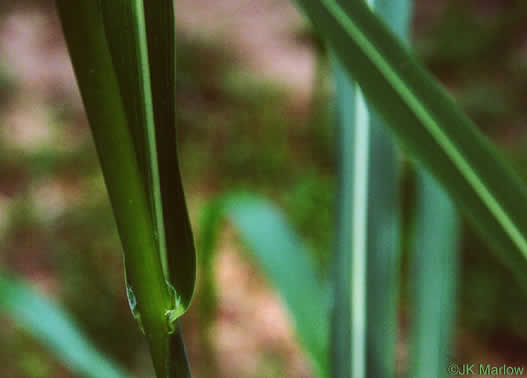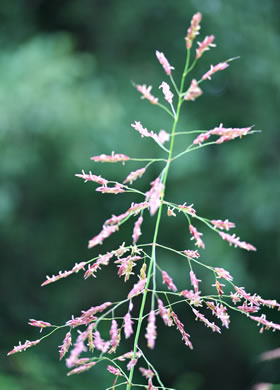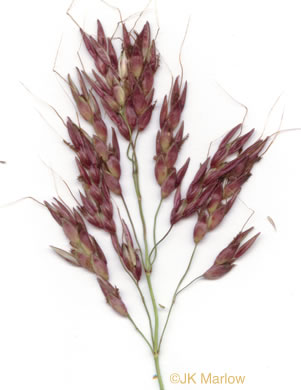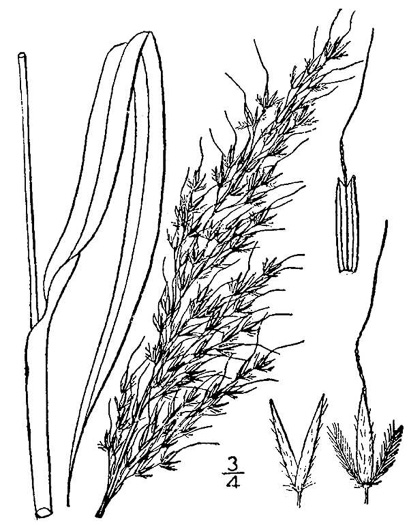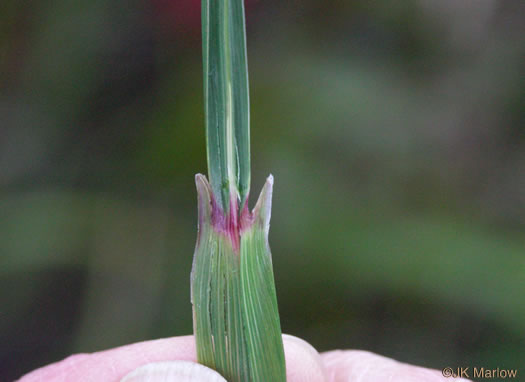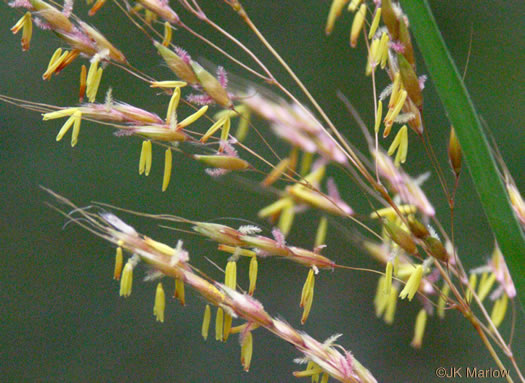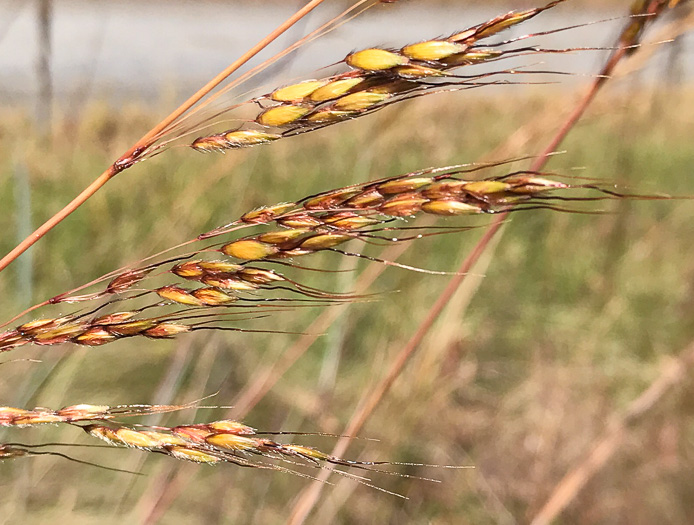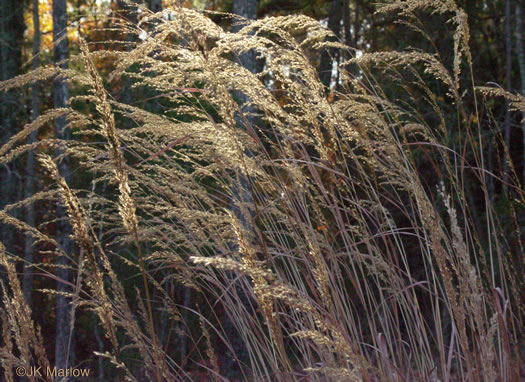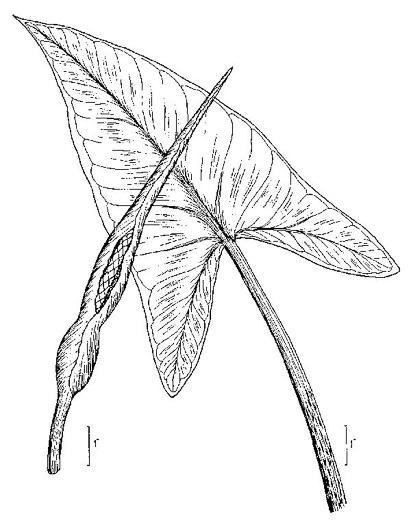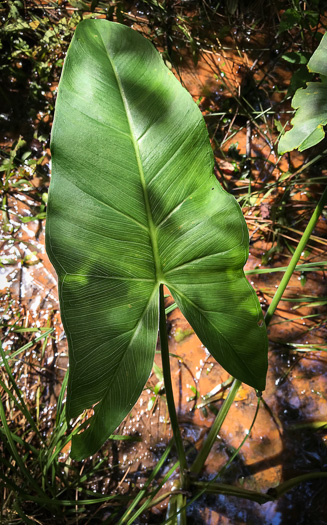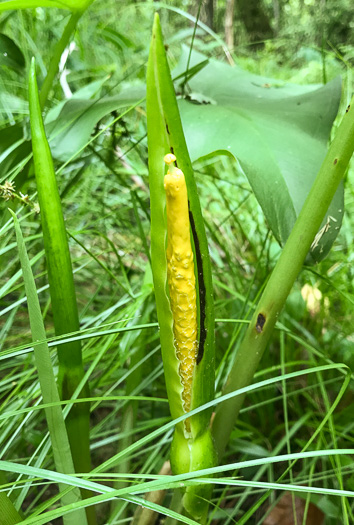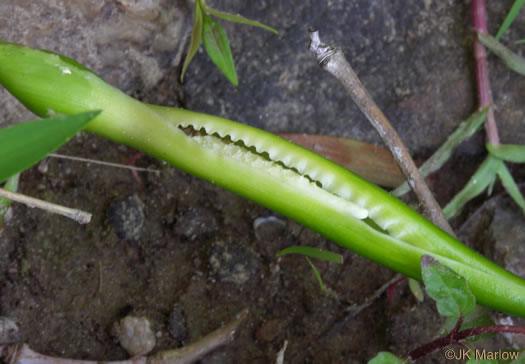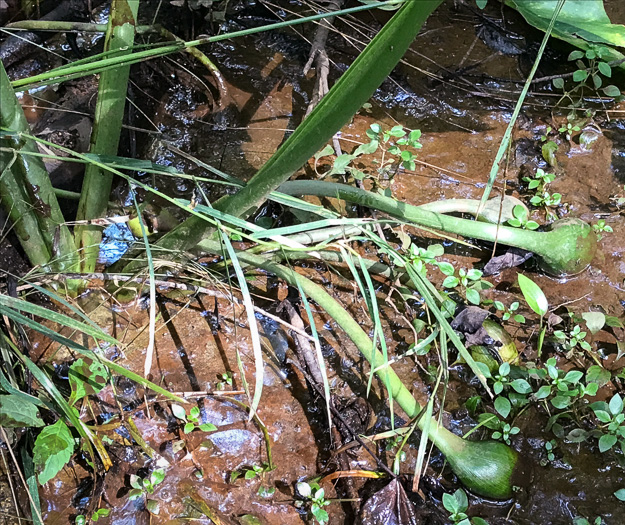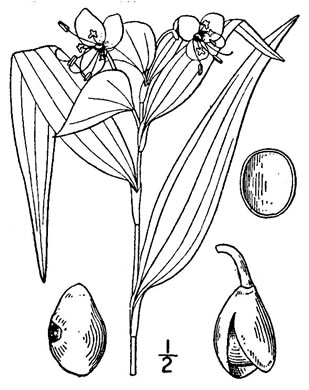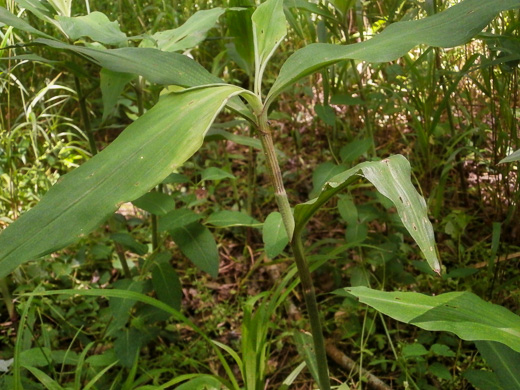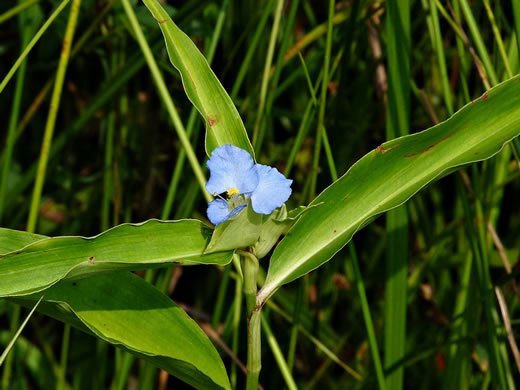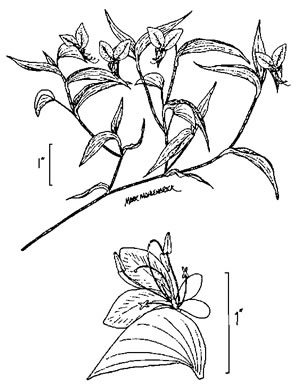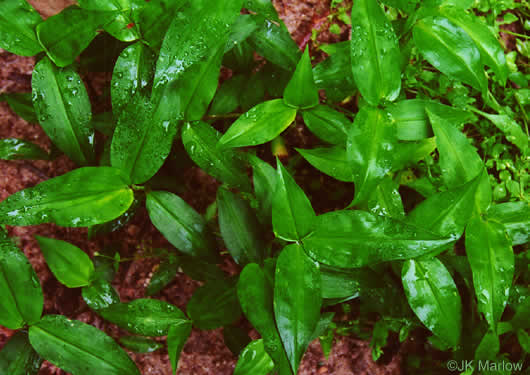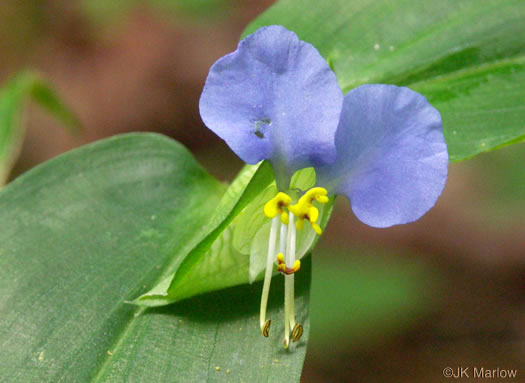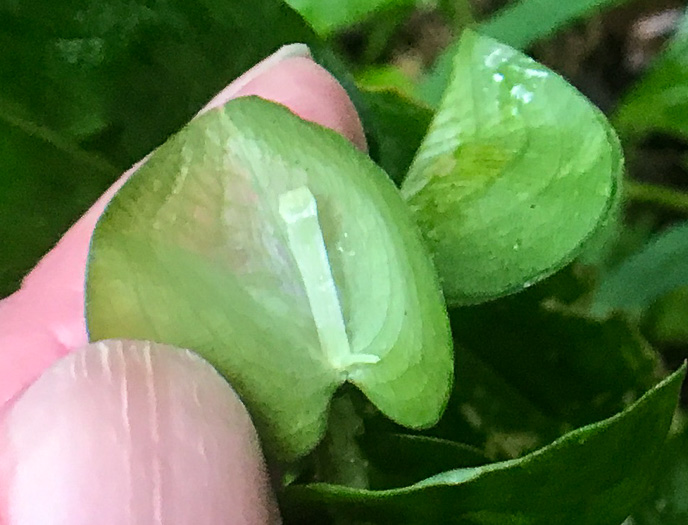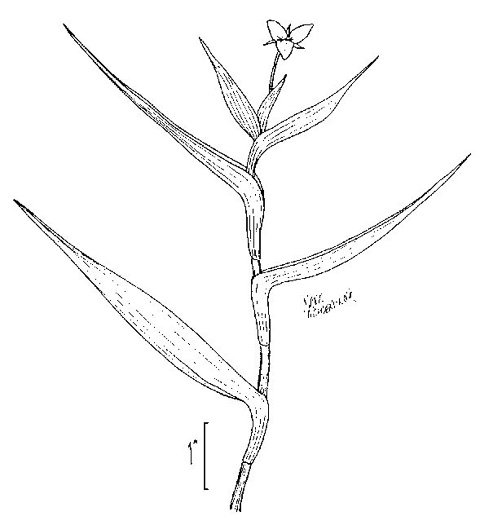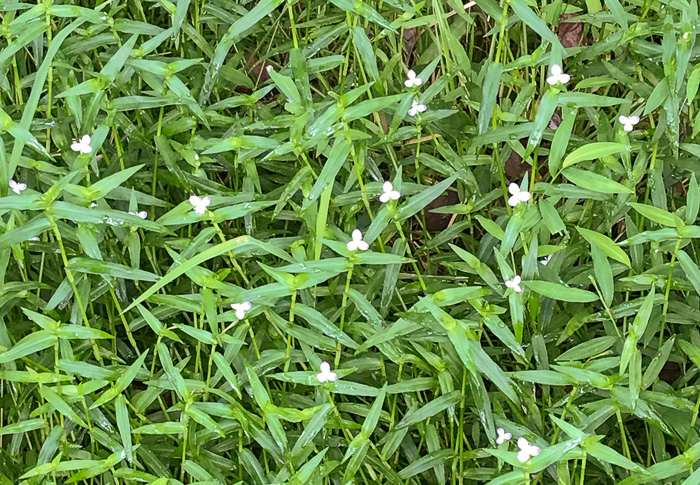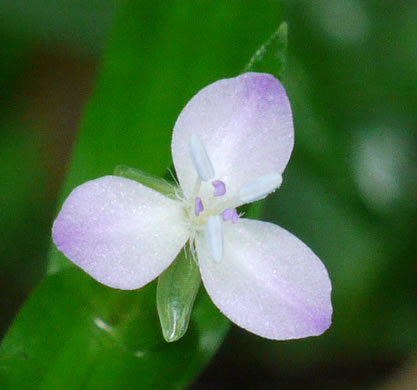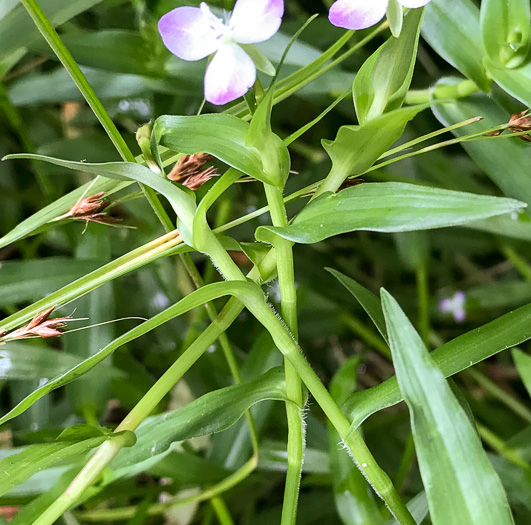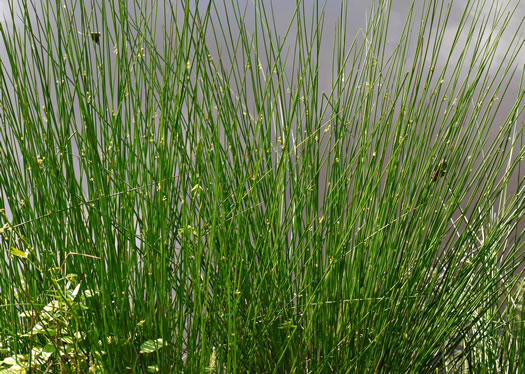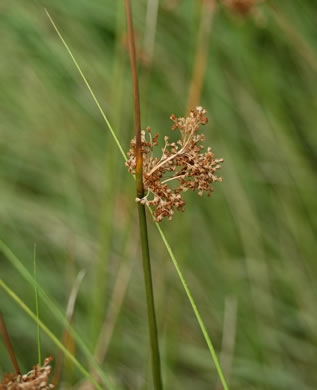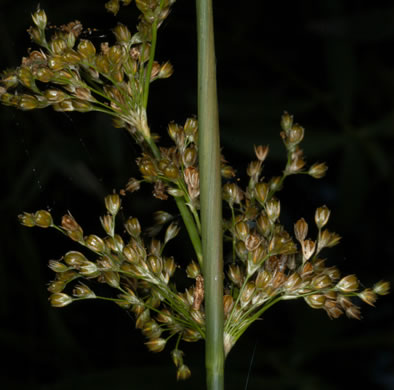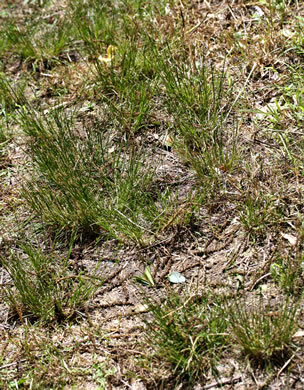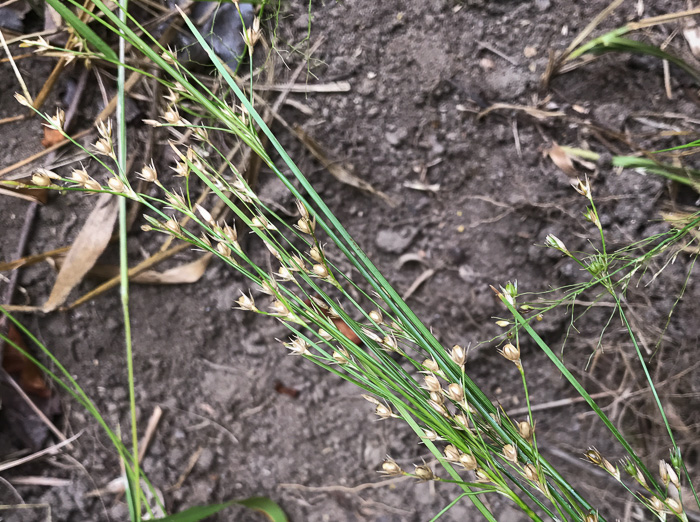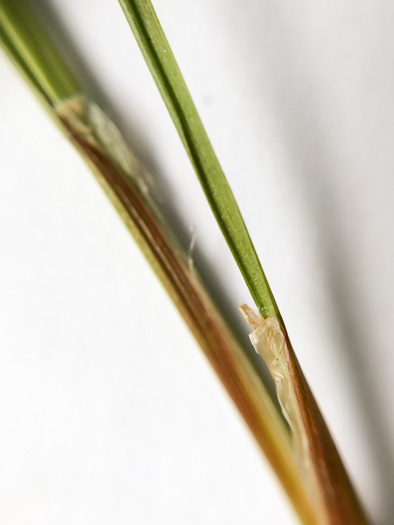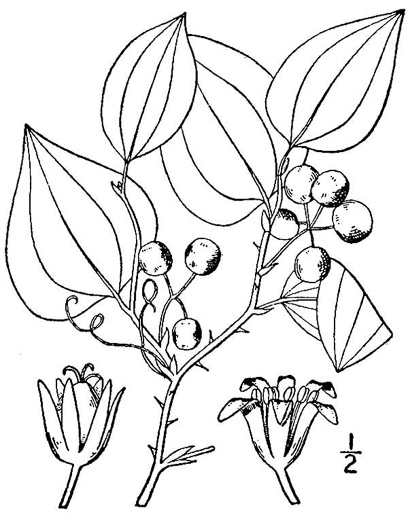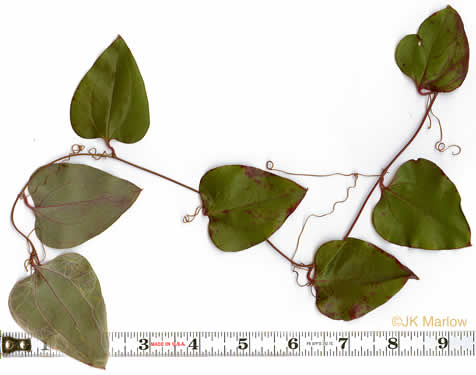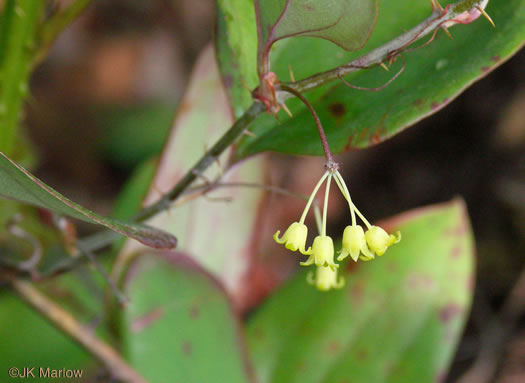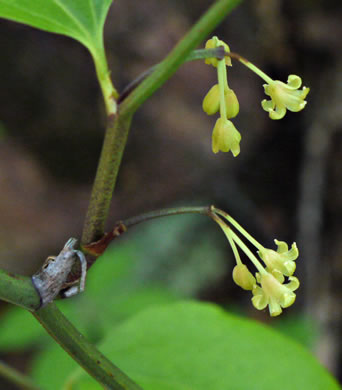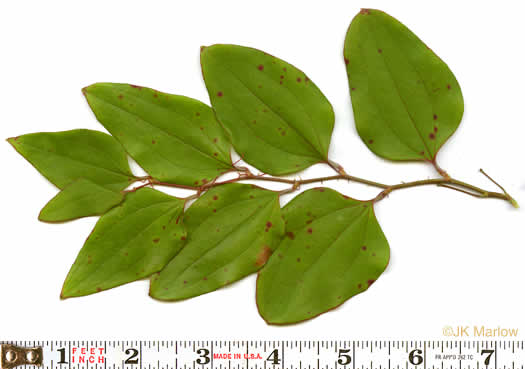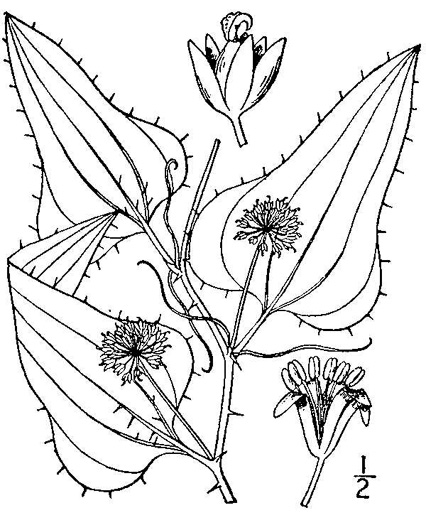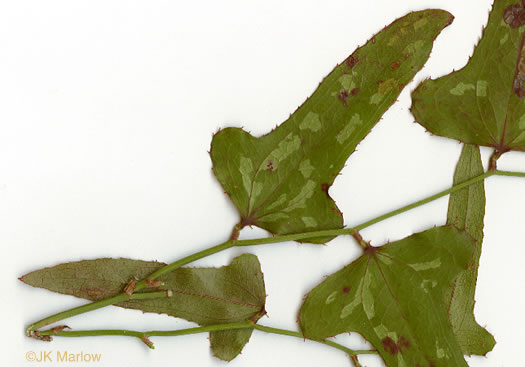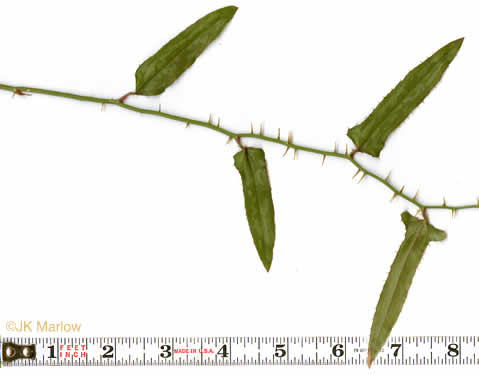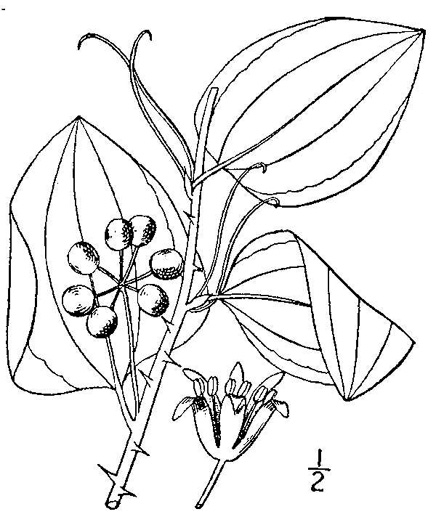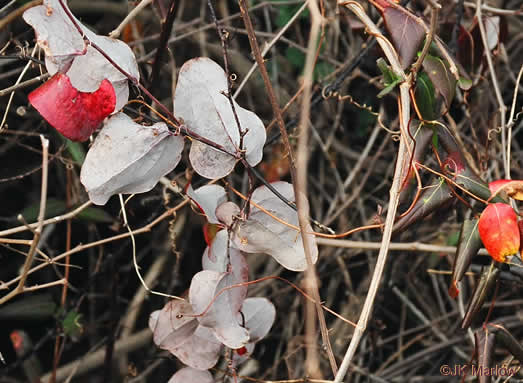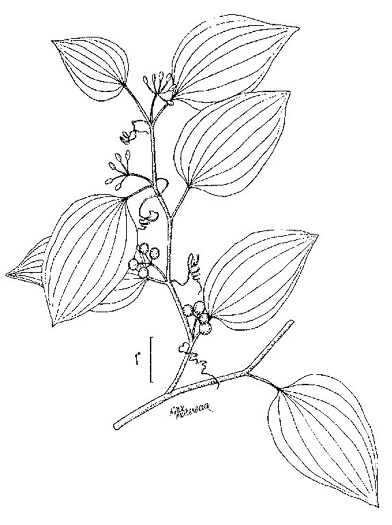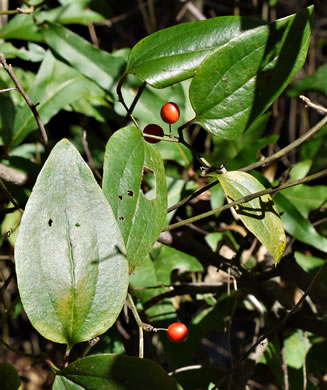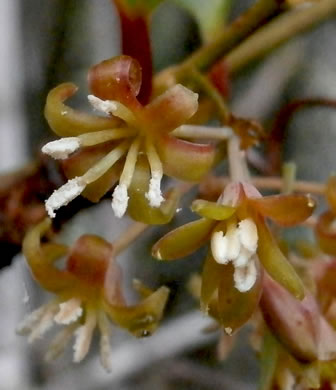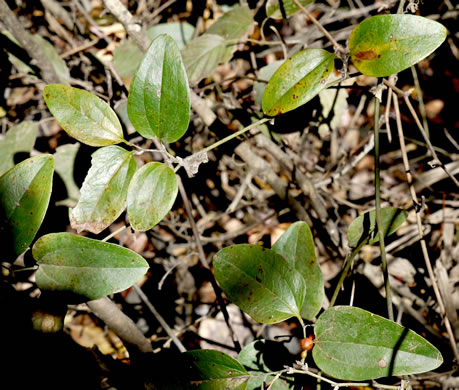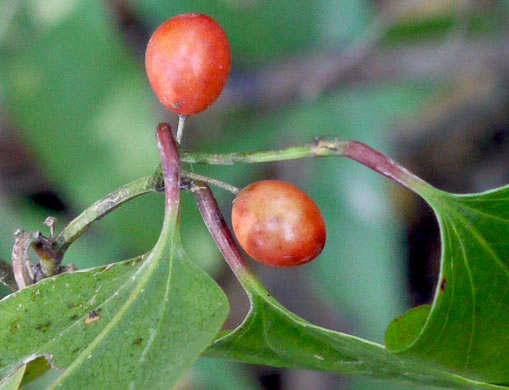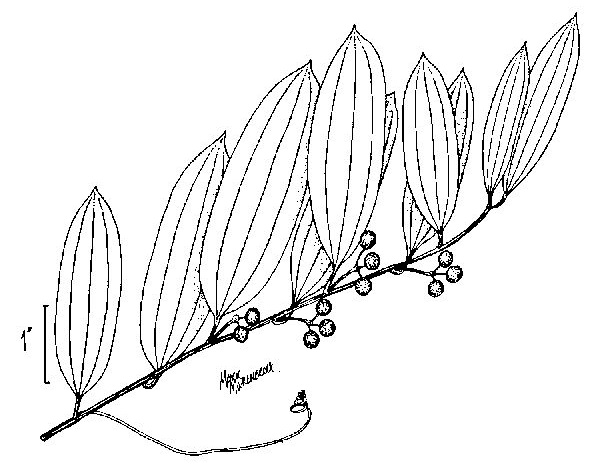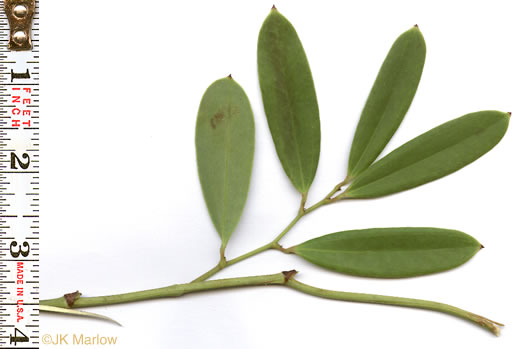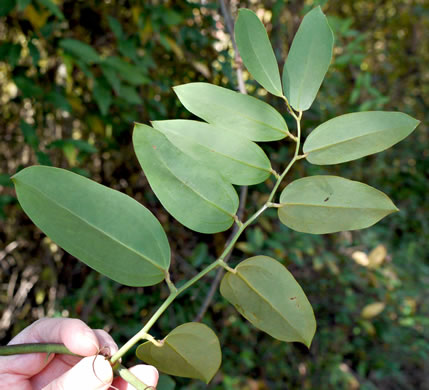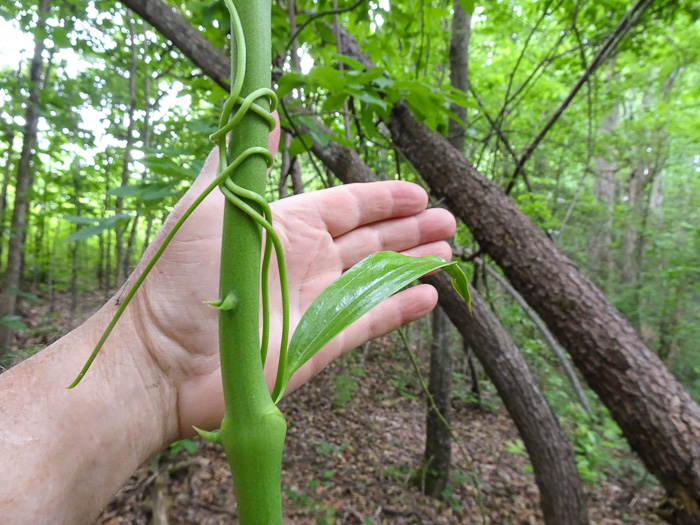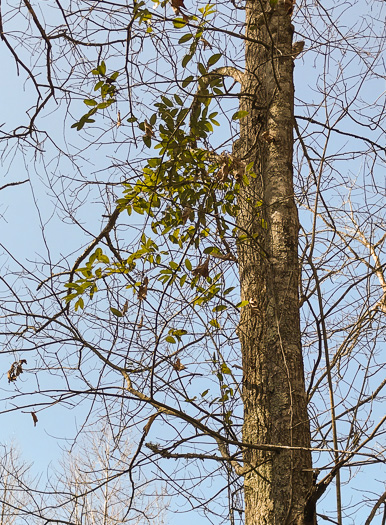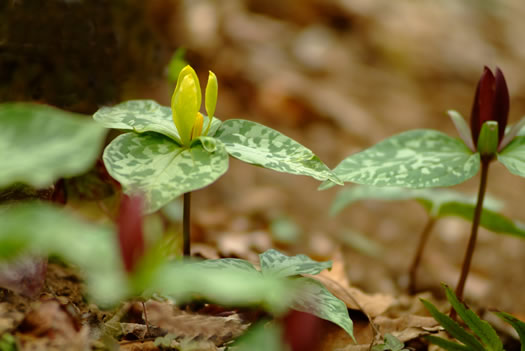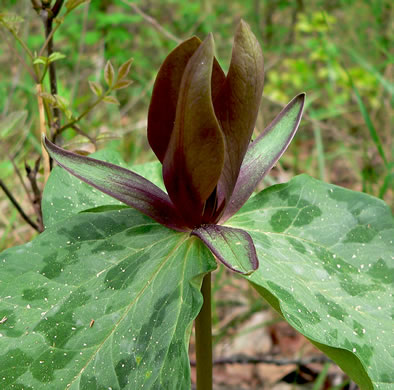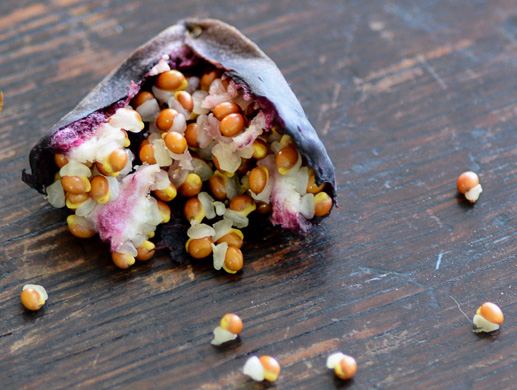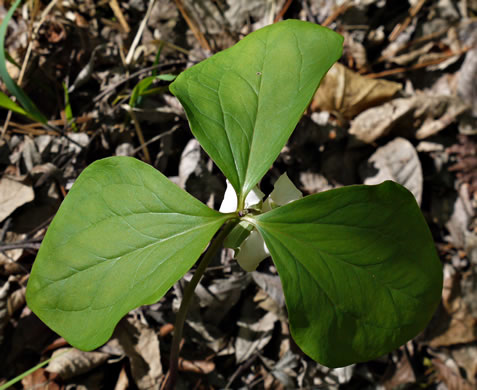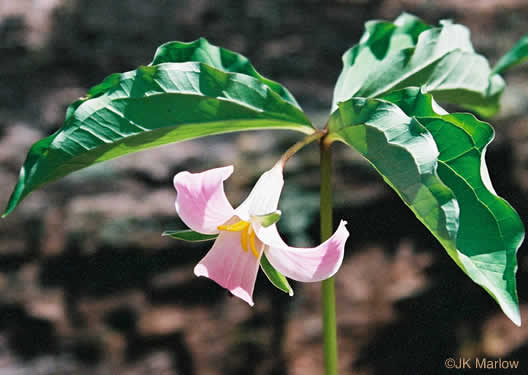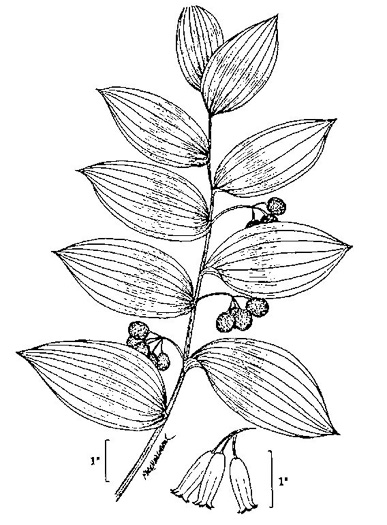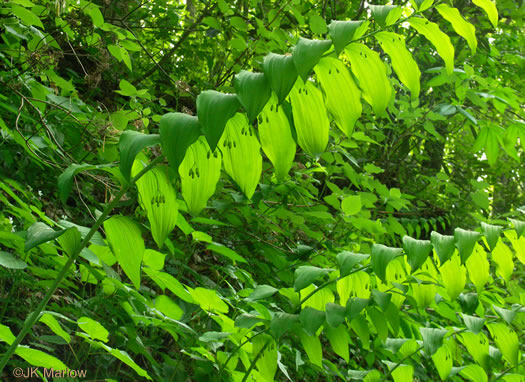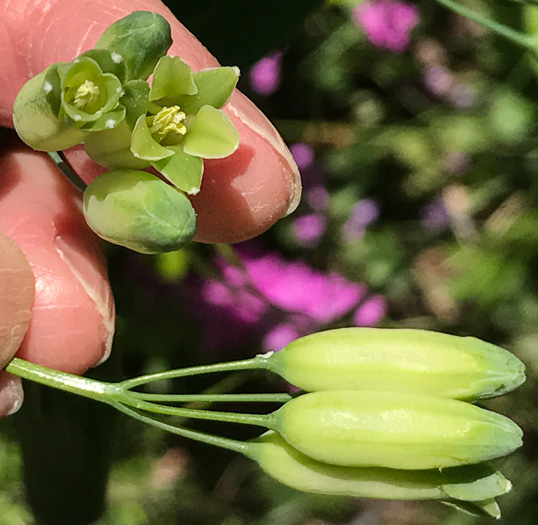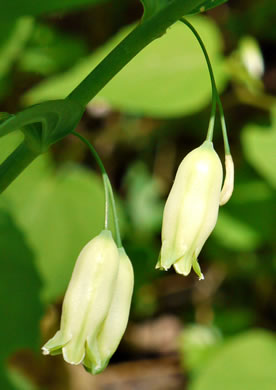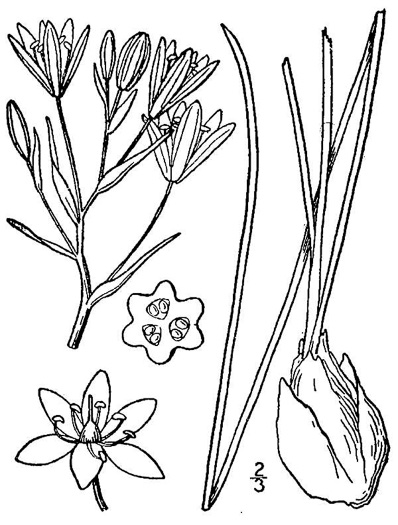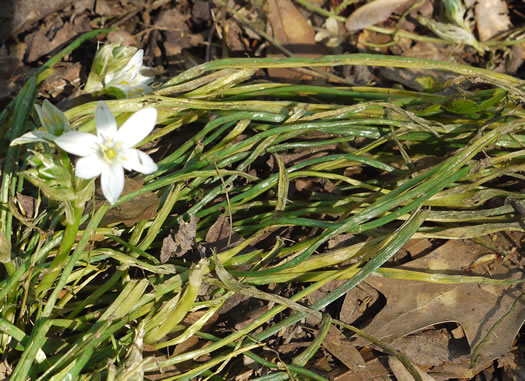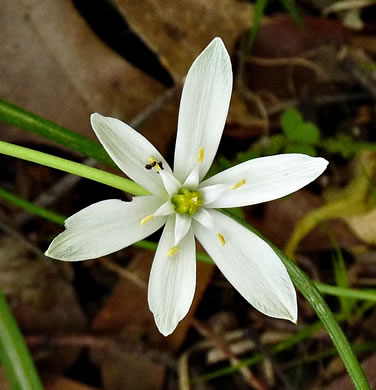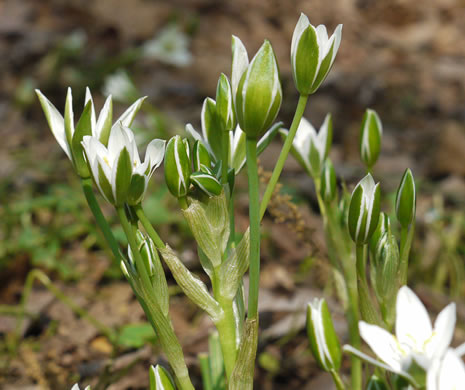Hovering over an image will enlarge it and point out features (works better on desktop than on mobile).
![]() A camera indicates there are pictures.
A camera indicates there are pictures.
![]() A speaker indicates that a botanical name is pronounced.
A speaker indicates that a botanical name is pronounced.
![]() A plus sign after a Latin name indicates that the species is further divided into varieties or subspecies.
A plus sign after a Latin name indicates that the species is further divided into varieties or subspecies.
Most habitat and range descriptions were obtained from Weakley's Flora.
Your search found 401 taxa.
Clicking ![]() one takes you to more information and/or pictures.
one takes you to more information and/or pictures.

![]()
![]() Common Name:
Japanese Climbing Fern
Common Name:
Japanese Climbing Fern
Weakley's Flora: (4/24/22) Lygodium japonicum FAMILY: Lygodiaceae
SYNONYMOUS WITH PLANTS National Database: Lygodium japonicum FAMILY: Lygodiaceae
SYNONYMOUS WITH Vascular Flora of the Carolinas (Radford, Ahles, & Bell, 1968): Lygodium japonicum 008-01-002 FAMILY: Schizaeaceae
Habitat: Disturbed areas
Common in Coastal Plain of GA & SC, uncommon in Piedmont of GA & SC (rare elsewhere in GA-NC-SC)
Non-native: east Asia

![]()
![]() Common Name:
Southern Lady Fern
Common Name:
Southern Lady Fern
Weakley's Flora: (4/24/22) Athyrium asplenioides FAMILY: Athyriaceae
SYNONYMOUS WITH PLANTS National Database: Athyrium filix-femina ssp. asplenioides FAMILY: Dryopteridaceae
SYNONYMOUS WITH Vascular Flora of the Carolinas (Radford, Ahles, & Bell, 1968): Athyrium asplenioides 011-01-001 FAMILY: Aspidiaceae
Habitat: Moist forests
Common
Native to the Carolinas & Georgia

![]()
![]() Common Name:
Silvery Glade Fern, Silvery Spleenwort
Common Name:
Silvery Glade Fern, Silvery Spleenwort
Weakley's Flora: (4/24/22) Deparia acrostichoides FAMILY: Athyriaceae
SYNONYMOUS WITH PLANTS National Database: Deparia acrostichoides FAMILY: Dryopteridaceae
SYNONYMOUS WITH Vascular Flora of the Carolinas (Radford, Ahles, & Bell, 1968): Athyrium thelypterioides 011-01-002 FAMILY: Aspidiaceae
Habitat: Moist forests, cove forests
Common in Mountains, uncommon in Piedmont, rare in Coastal Plain
Native to the Carolinas & Georgia

![]() Common Name:
Autumn Fern, Japanese Red Shield-fern, Japanese Shield-fern
Common Name:
Autumn Fern, Japanese Red Shield-fern, Japanese Shield-fern
Weakley's Flora: (4/14/23) Dryopteris erythrosora FAMILY: Dryopteridaceae
Habitat: Suburban woodlands, especially in ravines and along creeks
Uncommon in GA Piedmont, rare elsewhere
Non-native: Japan, China & Korea

![]()
![]() Common Name:
Christmas Fern
Common Name:
Christmas Fern
Weakley's Flora: (4/14/23) Polystichum acrostichoides FAMILY: Dryopteridaceae
SYNONYMOUS WITH PLANTS National Database: Polystichum acrostichoides FAMILY: Dryopteridaceae
SYNONYMOUS WITH Vascular Flora of the Carolinas (Radford, Ahles, & Bell, 1968): Polystichum acrostichoides 011-05-001 FAMILY: Aspidiaceae
Habitat: Moist to dry forests and woodlands, especially slopes, ravines, and small stream bottomlands
Common
Native to the Carolinas & Georgia

![]() Common Name:
Japanese Holly-fern, Asian Net-veined Holly Fern
Common Name:
Japanese Holly-fern, Asian Net-veined Holly Fern
Weakley's Flora: (4/24/22) Cyrtomium falcatum FAMILY: Dryopteridaceae
SYNONYMOUS WITH PLANTS National Database: Cyrtomium falcatum FAMILY: Dryopteridaceae
Habitat: Ditches, disturbed swamps, moist ravines, old mortar of brick walls
Rare
Non-native: east Asia

![]()
![]() Common Name:
Mariana Maiden-fern, Swordfern, False Maiden-fern
Common Name:
Mariana Maiden-fern, Swordfern, False Maiden-fern
Weakley's Flora: (4/24/22) Macrothelypteris torresiana FAMILY: Thelypteridaceae
SYNONYMOUS WITH PLANTS National Database: Macrothelypteris torresiana FAMILY: Thelypteridaceae
Habitat: Wet hammocks, cypress swamps, streamsides, moist forests, disturbed areas, increasingly invasive in natural habitats (especially in the southern parts of our area)
Uncommon (rare in NC) (rare in SC Mountains)
Non-native: Asian & African tropics

![]()
![]() Common Name:
Sensitive Fern, Bead Fern
Common Name:
Sensitive Fern, Bead Fern
Weakley's Flora: (4/24/22) Onoclea sensibilis FAMILY: Onocleaceae
INCLUDED WITHIN PLANTS National Database: Onoclea sensibilis FAMILY: Dryopteridaceae
INCLUDED WITHIN Vascular Flora of the Carolinas (Radford, Ahles, & Bell, 1968): Onoclea sensibilis 011-07-001 FAMILY: Aspidiaceae
Habitat: Marshes, swamps, ditches, wet disturbed places
Common
Native to the Carolinas & Georgia

![]()
![]() Common Name:
Netted Chain-fern, Net-veined Chainfern
Common Name:
Netted Chain-fern, Net-veined Chainfern
Weakley's Flora: (4/24/22) Lorinseria areolata FAMILY: Blechnaceae
SYNONYMOUS WITH PLANTS National Database: Woodwardia areolata FAMILY: Blechnaceae
SYNONYMOUS WITH Vascular Flora of the Carolinas (Radford, Ahles, & Bell, 1968): Woodwardia areolata 012-01-002 FAMILY: Blechnaceae
Habitat: Moist to wet, acid, organic soils, such as bogs, blackwater bottomlands, pocosins, wet hammocks
Common (uncommon in NC Mountains)
Native to the Carolinas & Georgia

![]()
![]() Common Name:
Ebony Spleenwort
Common Name:
Ebony Spleenwort
Weakley's Flora: (4/14/23) Asplenium platyneuron FAMILY: Aspleniaceae
SYNONYMOUS WITH PLANTS National Database: Asplenium platyneuron FAMILY: Aspleniaceae
SYNONYMOUS WITH Vascular Flora of the Carolinas (Radford, Ahles, & Bell, 1968): Asplenium platyneuron 013-01-003 FAMILY: Aspleniaceae
Habitat: Moist to dry soils of forests, woodlands, old fields; also on outcrops, especially of calcareous rocks and in masonry crevices, at low to moderate elevations
Common
Native to the Carolinas & Georgia

![]()
![]() Common Name:
Loblolly Pine, Old Field Pine
Common Name:
Loblolly Pine, Old Field Pine
Weakley's Flora: (4/24/22) Pinus taeda FAMILY: Pinaceae
SYNONYMOUS WITH PLANTS National Database: Pinus taeda FAMILY: Pinaceae
SYNONYMOUS WITH Vascular Flora of the Carolinas (Radford, Ahles, & Bell, 1968): Pinus taeda 016-01-004 FAMILY: Pinaceae
Habitat: Dry to dry-mesic upland forests and woodlands, riparian forests, maritime forests, sandy rises in bottomland forests, pine flatwoods, roadsides, pine plantations, disturbed areas, especially in acid soil, much more abundant and widespread than formerly, and occurring farther inland than as a native
Common (rare in Mountains)
Native to the Carolinas & Georgia

![]()
![]() Common Name:
Virginia Pine, Scrub Pine, Jersey Pine, Possum Pine
Common Name:
Virginia Pine, Scrub Pine, Jersey Pine, Possum Pine
Weakley's Flora: (4/14/23) Pinus virginiana FAMILY: Pinaceae
SYNONYMOUS WITH PLANTS National Database: Pinus virginiana FAMILY: Pinaceae
SYNONYMOUS WITH Vascular Flora of the Carolinas (Radford, Ahles, & Bell, 1968): Pinus virginiana 016-01-010 FAMILY: Pinaceae
Habitat: Dry forests and woodlands, especially on slopes and ridges, also common in certain areas as a weedy successional tree on nearly any kind of site, such as rocky, sandy, or clayey successional old fields or blowdowns
Common (rare in Coastal Plain)
Native to the Carolinas & Georgia

![]()
![]() Common Name:
Eastern Hemlock, Canada Hemlock, Spruce Pine, Hemlock Spruce
Common Name:
Eastern Hemlock, Canada Hemlock, Spruce Pine, Hemlock Spruce
Weakley's Flora: (4/14/23) Tsuga canadensis FAMILY: Pinaceae
SYNONYMOUS WITH PLANTS National Database: Tsuga canadensis FAMILY: Pinaceae
SYNONYMOUS WITH Vascular Flora of the Carolinas (Radford, Ahles, & Bell, 1968): Tsuga canadensis 016-03-001 FAMILY: Pinaceae
Habitat: In a wide variety of habitats in the mountains, most typically and abundantly in moist sites in ravines or coves along streams, but likely to be found in all but the driest habitats between 300 and 1500 m (even occurring in peaty bogs, where it has a sickly yellow color and short life expectancy); in the western Piedmont of NC limited to progressively rarer microhabitats (primarily north-facing river bluffs), reaching its eastward limit in NC at a disjunct stand at Hemlock Bluff State Natural Area, Wake County (but uncommon in the Piedmont of VA and even present, though rare, in the Coastal Plain of VA)
Common in Mountains, rare in Piedmont
Native to the Carolinas & Georgia

![]()
![]() Common Name:
Eastern Red Cedar
Common Name:
Eastern Red Cedar
Weakley's Flora: (4/24/22) Juniperus virginiana FAMILY: Cupressaceae
SYNONYMOUS WITH PLANTS National Database: Juniperus virginiana var. virginiana FAMILY: Cupressaceae
SYNONYMOUS WITH Vascular Flora of the Carolinas (Radford, Ahles, & Bell, 1968): Juniperus virginiana 018-03-002 FAMILY: Cupressaceae
Habitat: Bluffs, glades, upland forests and woodlands, pastures, old fields, roadsides, and fencerows, primarily upland, occurring most abundantly on (but by no means restricted to) circumneutral soils (including shrink-swell clays) derived from mafic or calcareous rocks
Common (uncommon in GA Coastal Plain)
Native to the Carolinas & Georgia

![]()
![]() Common Name:
Common Cattail, Broadleaf Cattail
Common Name:
Common Cattail, Broadleaf Cattail
Weakley's Flora: (4/24/22) Typha latifolia FAMILY: Typhaceae
SYNONYMOUS WITH PLANTS National Database: Typha latifolia FAMILY: Typhaceae
SYNONYMOUS WITH Vascular Flora of the Carolinas (Radford, Ahles, & Bell, 1968): Typha latifolia 019-01-001 FAMILY: Typhaceae
Habitat: Fresh waters of ponds, lakes, ditches, marshes, including in tidal freshwater marshes
Common
Native to the Carolinas & Georgia

![]()
![]() Common Name:
Bunched Arrowhead
Common Name:
Bunched Arrowhead
Weakley's Flora: (4/14/23) Sagittaria fasciculata FAMILY: Alismataceae
SYNONYMOUS WITH PLANTS National Database: Sagittaria fasciculata FAMILY: Alismataceae
SYNONYMOUS WITH Vascular Flora of the Carolinas (Radford, Ahles, & Bell, 1968): Sagittaria fasciculata 027-03-005 FAMILY: Alismataceae
Habitat: Bogs, ditches adjacent to drained bogs, wooded seepage areas
Rare, endemic to a several-county area in sw. NC & nw. SC
Native to the Carolinas

![]()
![]() Common Name:
Broadleaf Arrowhead, Duck Potato, Common Arrowhead
Common Name:
Broadleaf Arrowhead, Duck Potato, Common Arrowhead
Weakley's Flora: (4/14/23) Sagittaria latifolia + FAMILY: Alismataceae
INCLUDED WITHIN PLANTS National Database: Sagittaria latifolia FAMILY: Alismataceae
Vascular Flora of the Carolinas (Radford, Ahles, & Bell, 1968): Sagittaria latifolia + 027-03-009 FAMILY: Alismataceae
Look for it in bogs, marshes, and - in the case of var. latifolia - swamps, farm ponds, ditches
Common (var. pubescens is uncommon in GA Piedmont & NC Coastal Plain and rare in Coastal Plain of GA & SC)
Native to the Carolinas & Georgia

![]()
![]() Common Name:
River Cane, Giant Cane
Common Name:
River Cane, Giant Cane
Weakley's Flora: (4/24/22) Arundinaria gigantea FAMILY: Poaceae
SYNONYMOUS WITH PLANTS National Database: Arundinaria gigantea FAMILY: Poaceae
INCLUDED WITHIN Vascular Flora of the Carolinas (Radford, Ahles, & Bell, 1968): Arundinaria gigantea 029-01-001 FAMILY: Poaceae
Habitat: Bottomland and riparian forests, lower slopes and bluffs along streams, seeps, stream banks, and extending into less mesic and even dry settings on circumneutral or alkaline soils over limestone or dolomite, or in loess deposits along the Mississippi River
Common (uncommon in Carolina Piedmont, rare in SC Coastal Plain)
Native to the Carolinas & Georgia

![]()
![]() Common Name:
Golden Bamboo, Fishpole Bamboo
Common Name:
Golden Bamboo, Fishpole Bamboo
Weakley's Flora: (4/24/22) Phyllostachys aurea FAMILY: Poaceae
SYNONYMOUS WITH PLANTS National Database: Phyllostachys aurea FAMILY: Poaceae
SYNONYMOUS WITH Vascular Flora of the Carolinas (Radford, Ahles, & Bell, 1968): Phyllostachys aurea 029-02-001 FAMILY: Poaceae
Habitat: Suburban woodlands, upland forests and woodlands, riparian forests, stream banks, roadsides, pastures, old fields, persisting and spreading from plantings
Common in GA (uncommon in NC Mountains, Carolina Piedmont, & Carolina Coastal Plain) (rare in SC Mountains)
Non-native: China & Japan

![]()
![]() Common Name:
River Oats, Northern Sea Oats, Fish-on-a-stringer, Indian Woodoats
Common Name:
River Oats, Northern Sea Oats, Fish-on-a-stringer, Indian Woodoats
Weakley's Flora: (4/24/22) Chasmanthium latifolium FAMILY: Poaceae
SYNONYMOUS WITH PLANTS National Database: Chasmanthium latifolium FAMILY: Poaceae
SYNONYMOUS WITH Vascular Flora of the Carolinas (Radford, Ahles, & Bell, 1968): Uniola latifolia 029-10-003 FAMILY: Poaceae
Habitat: Riverbanks, streambanks, bottomland forests, seepages and glades over mafic or calcareous rock, usually in nutrient-rich soils, also now cultivated widely as a native plant ornamental, but can be quite aggressive
Common
Native to the Carolinas & Georgia

![]()
![]() Common Name:
Weeping Lovegrass
Common Name:
Weeping Lovegrass
Weakley's Flora: (4/24/22) Eragrostis curvula FAMILY: Poaceae
SYNONYMOUS WITH PLANTS National Database: Eragrostis curvula FAMILY: Poaceae
SYNONYMOUS WITH Vascular Flora of the Carolinas (Radford, Ahles, & Bell, 1968): Eragrostis curvula 029-11-007 FAMILY: Poaceae
Habitat: Roadsides
Common (uncommon in Mountains)
Non-native: southern Africa

![]()
![]() Common Name:
Orchard Grass
Common Name:
Orchard Grass
Weakley's Flora: (4/24/22) Dactylis glomerata FAMILY: Poaceae
INCLUDING PLANTS National Database: Dactylis glomerata ssp. glomerata FAMILY: Poaceae
SYNONYMOUS WITH Vascular Flora of the Carolinas (Radford, Ahles, & Bell, 1968): Dactylis glomerata 029-13-001 FAMILY: Poaceae
Habitat: Pastures, fields, woodland edges, roadsides
Common in GA Mountains & GA Piedmont (uncommon elsewhere in GA-NC-SC)
Non-native: Europe

![]()
![]() Common Name:
Rescue Grass
Common Name:
Rescue Grass
Weakley's Flora: (4/24/22) Bromus catharticus var. catharticus FAMILY: Poaceae
(?) PLANTS National Database: Bromus catharticus FAMILY: Poaceae
(?) Vascular Flora of the Carolinas (Radford, Ahles, & Bell, 1968): Bromus catharticus 029-14-007 FAMILY: Poaceae
Habitat: Cultivated fields, roadsides, disturbed areas
Common (rare in Mountains)
Non-native: South America

![]()
![]() Common Name:
Virginia Wild-rye, Common Eastern Wild-rye, Terrell Grass
Common Name:
Virginia Wild-rye, Common Eastern Wild-rye, Terrell Grass
Weakley's Flora: (4/24/22) Elymus virginicus FAMILY: Poaceae
INCLUDED WITHIN PLANTS National Database: Elymus virginicus var. virginicus FAMILY: Poaceae
INCLUDED WITHIN Vascular Flora of the Carolinas (Radford, Ahles, & Bell, 1968): Elymus virginicus 029-25-002 FAMILY: Poaceae
Habitat: Moist forests
Common
Native to the Carolinas & Georgia

![]()
![]() Common Name:
Elegant Hairgrass, Annual Silver Hairgrass
Common Name:
Elegant Hairgrass, Annual Silver Hairgrass
Weakley's Flora: (4/14/23) Aira elegans FAMILY: Poaceae
SYNONYMOUS WITH PLANTS National Database: Aira elegans FAMILY: Poaceae
SYNONYMOUS WITH Vascular Flora of the Carolinas (Radford, Ahles, & Bell, 1968): Aira elegans 029-35-002 FAMILY: Poaceae
Habitat: Fields, roadsides, disturbed areas
Common to uncommon to rare
Non-native: Europe

![]()
![]() Common Name:
Green Needlegrass, Blackseed Needlegrass, Eastern Needlegrass, Black Oatgrass
Common Name:
Green Needlegrass, Blackseed Needlegrass, Eastern Needlegrass, Black Oatgrass
Weakley's Flora: (4/24/22) Piptochaetium avenaceum FAMILY: Poaceae
SYNONYMOUS WITH PLANTS National Database: Piptochaetium avenaceum FAMILY: Poaceae
SYNONYMOUS WITH Vascular Flora of the Carolinas (Radford, Ahles, & Bell, 1968): Stipa avenacea 029-37-001 FAMILY: Poaceae
Habitat: Upland woodlands and forests, sometimes abundant or even dominant in xeric woodlands over granitic or mafic rocks in the Piedmont
Common (uncommon in Mountains)
Native to the Carolinas & Georgia

![]() Common Name:
Bermuda Grass, Scutch Grass
Common Name:
Bermuda Grass, Scutch Grass
Weakley's Flora: (4/24/22) Cynodon dactylon FAMILY: Poaceae
SYNONYMOUS WITH PLANTS National Database: Cynodon dactylon FAMILY: Poaceae
SYNONYMOUS WITH Vascular Flora of the Carolinas (Radford, Ahles, & Bell, 1968): Cynodon dactylon 029-54-001 FAMILY: Poaceae
Habitat: Lawns, gardens, roadsides, pastures, fields, disturbed areas
Common
Non-native: Eurasia

![]()
![]() Common Name:
Sweet Vernal Grass
Common Name:
Sweet Vernal Grass
Weakley's Flora: (4/24/22) Anthoxanthum odoratum FAMILY: Poaceae
SYNONYMOUS WITH PLANTS National Database: Anthoxanthum odoratum ssp. odoratum FAMILY: Poaceae
SYNONYMOUS WITH Vascular Flora of the Carolinas (Radford, Ahles, & Bell, 1968): Anthoxanthum odoratum 029-60-002 FAMILY: Poaceae
Habitat: Lawns, roadsides, disturbed areas
Common in Carolinas (uncommon to rare in GA)
Non-native: Europe

![]()
![]() Common Name:
Yellow Foxtail
Common Name:
Yellow Foxtail
Weakley's Flora: (4/24/22) Setaria pumila FAMILY: Poaceae
INCLUDING & INCLUDED WITHIN PLANTS National Database: Setaria pumila ssp. pallidefusca FAMILY: Poaceae
SYNONYMOUS WITH (MISAPPLIED) Vascular Flora of the Carolinas (Radford, Ahles, & Bell, 1968): Setaria glauca 029-68-004 FAMILY: Poaceae
Habitat: Disturbed areas, lawns, fields, less commonly in natural habitats
Common
Non-native: Europe

![]() Common Name:
Nodding Foxtail Grass, Giant Foxtail-grass, Chinese Foxtail
Common Name:
Nodding Foxtail Grass, Giant Foxtail-grass, Chinese Foxtail
Weakley's Flora: (4/24/22) Setaria faberi FAMILY: Poaceae
SYNONYMOUS WITH PLANTS National Database: Setaria faberi FAMILY: Poaceae
SYNONYMOUS WITH Vascular Flora of the Carolinas (Radford, Ahles, & Bell, 1968): Setaria faberi 029-68-007 FAMILY: Poaceae
Habitat: Fields, pastures, roadsides, gardens, other disturbed areas
Common (uncommon GA Piedmont & NC Coastal Plain) (rare in Coastal Plain of GA & SC)
Non-native: China

![]()
![]() Common Name:
Green Foxtail, Green Bristlegrass
Common Name:
Green Foxtail, Green Bristlegrass
Weakley's Flora: (4/24/22) Setaria viridis var. viridis FAMILY: Poaceae
SYNONYMOUS WITH PLANTS National Database: Setaria viridis var. viridis FAMILY: Poaceae
INCLUDED WITHIN Vascular Flora of the Carolinas (Radford, Ahles, & Bell, 1968): Setaria viridis 029-68-008 FAMILY: Poaceae
Habitat: Fields, pastures, roadsides, other disturbed areas
Common in Mountains (common elsewhere in NC, uncommon elsewhere in SC, rare elsewhere in GA)
Non-native: Eurasia

![]()
![]() Common Name:
Vasey Grass
Common Name:
Vasey Grass
Weakley's Flora: (4/24/22) Paspalum urvillei FAMILY: Poaceae
SYNONYMOUS WITH PLANTS National Database: Paspalum urvillei FAMILY: Poaceae
SYNONYMOUS WITH Vascular Flora of the Carolinas (Radford, Ahles, & Bell, 1968): Paspalum urvillei 029-74-007 FAMILY: Poaceae
Habitat: Roadsides, fields, and other disturbed areas
Common (rare in Mountains)
Non-native: South America

![]()
![]() Common Name:
Hairy Crabgrass, Northern Crabgrass
Common Name:
Hairy Crabgrass, Northern Crabgrass
Weakley's Flora: (4/24/22) Digitaria sanguinalis FAMILY: Poaceae
SYNONYMOUS WITH PLANTS National Database: Digitaria sanguinalis FAMILY: Poaceae
SYNONYMOUS WITH Vascular Flora of the Carolinas (Radford, Ahles, & Bell, 1968): Digitaria sanguinalis 029-75-003 FAMILY: Poaceae
Habitat: Fields, roadsides, disturbed areas
Common
Non-native: Eurasia

![]()
![]() Common Name:
Beaked Panicum, Beaked Panicgrass
Common Name:
Beaked Panicum, Beaked Panicgrass
Weakley's Flora: (4/24/22) Coleataenia anceps ssp. anceps FAMILY: Poaceae
INCLUDED WITHIN PLANTS National Database: Panicum anceps FAMILY: Poaceae
SYNONYMOUS WITH Vascular Flora of the Carolinas (Radford, Ahles, & Bell, 1968): Panicum anceps var. anceps 029-81-001a FAMILY: Poaceae
Habitat: Moist sandy woods, swamps, sloughs, roadsides, fields, waste places, often weedy
Common
Native to the Carolinas & Georgia

![]()
![]() Common Name:
Switchgrass, Prairie Switchgrass
Common Name:
Switchgrass, Prairie Switchgrass
Weakley's Flora: (4/14/23) Panicum virgatum var. virgatum FAMILY: Poaceae
INCLUDED WITHIN PLANTS National Database: Panicum virgatum var. virgatum FAMILY: Poaceae
INCLUDED WITHIN Vascular Flora of the Carolinas (Radford, Ahles, & Bell, 1968): Panicum virgatum 029-81-006 FAMILY: Poaceae
Habitat: Dry or wet sandy soils of pinelands, fresh and brackish marshes, tidal swamps, interdune swales and ponds, riverside scour prairies, mafic fens, calcareous fens and spring marshes, rocky river shores and bars, and also frequently planted
Common in Coastal Plain & GA Piedmont (uncommon to rare elsewhere in GA-NC-SC)
Native to the Carolinas & Georgia

![]()
![]() Common Name:
Velvet Witchgrass
Common Name:
Velvet Witchgrass
Weakley's Flora: (4/24/22) Dichanthelium scoparium FAMILY: Poaceae
SYNONYMOUS WITH PLANTS National Database: Dichanthelium scoparium FAMILY: Poaceae
SYNONYMOUS WITH Vascular Flora of the Carolinas (Radford, Ahles, & Bell, 1968): Panicum scoparium 029-81-057 FAMILY: Poaceae
Habitat: Moist sandy soil of woodland openings and ditches
Common (uncommon in Mountains, uncommon in GA Coastal Plain)
Native to the Carolinas & Georgia

![]()
![]() Common Name:
Japanese Stiltgrass, Japanese-grass, Nepalese Browntop, Nepal Grass
Common Name:
Japanese Stiltgrass, Japanese-grass, Nepalese Browntop, Nepal Grass
Weakley's Flora: (4/24/22) Microstegium vimineum FAMILY: Poaceae
SYNONYMOUS WITH PLANTS National Database: Microstegium vimineum FAMILY: Poaceae
SYNONYMOUS WITH Vascular Flora of the Carolinas (Radford, Ahles, & Bell, 1968): Microstegium vimineum 029-84-001 FAMILY: Poaceae
Habitat: Disturbed areas, colonizing moist, rich soil, especially in floodplains, though sometimes patchily in even dry or dry-mesic uplands
Common
Non-native: tropical southeast Asia

![]()
![]() Common Name:
Silver Plumegrass
Common Name:
Silver Plumegrass
Weakley's Flora: (4/24/22) Erianthus alopecuroides FAMILY: Poaceae
SYNONYMOUS WITH PLANTS National Database: Saccharum alopecuroides FAMILY: Poaceae
SYNONYMOUS WITH Vascular Flora of the Carolinas (Radford, Ahles, & Bell, 1968): Erianthus alopecuroides 029-85-001 FAMILY: Poaceae
Habitat: Dry to moist fields, roadsides, woodlands, and woodland borders
Common in Piedmont (rare in NC Mountains) (uncommon elsewhere in GA-NC-SC)
Native to the Carolinas & Georgia

![]()
![]() Common Name:
Sugarcane Plumegrass, Giant Plumegrass
Common Name:
Sugarcane Plumegrass, Giant Plumegrass
Weakley's Flora: (4/24/22) Erianthus giganteus FAMILY: Poaceae
SYNONYMOUS WITH PLANTS National Database: Saccharum giganteum FAMILY: Poaceae
SYNONYMOUS WITH Vascular Flora of the Carolinas (Radford, Ahles, & Bell, 1968): Erianthus giganteus 029-85-005 FAMILY: Poaceae
Habitat: Marshes, roadbanks, lake and pond margins, cypress ponds, wet pine flatwoods, ditches
Common (rare in Mountains)
Native to the Carolinas & Georgia

![]()
![]() Common Name:
Big Bluestem, Turkeyfoot
Common Name:
Big Bluestem, Turkeyfoot
Weakley's Flora: (4/24/22) Andropogon gerardi FAMILY: Poaceae
SYNONYMOUS WITH (ORTHOGRAPHIC VARIANT) PLANTS National Database: Andropogon gerardii FAMILY: Poaceae
SYNONYMOUS WITH (ORTHOGRAPHIC VARIANT) Vascular Flora of the Carolinas (Radford, Ahles, & Bell, 1968): Andropogon gerardii 029-87-002 FAMILY: Poaceae
Habitat: In a wide variety of habitats, usually rather dry, such as longleaf pine sandhills, glades, cliffs, and rock outcrops, in the Piedmont in woodlands, former prairie-like sites, woodlands, open forests, and river-scour grasslands, in the Mountains in glades, riverside scour areas, and rarely in grassy balds, ascending to at least 1600 m over mafic rocks (on Old Field Bald, Watauga and Ashe counties, NC)
Common
Native to the Carolinas & Georgia

![]()
![]() Common Name:
Splitbeard Bluestem, Silvery Bluestem
Common Name:
Splitbeard Bluestem, Silvery Bluestem
Weakley's Flora: (4/24/22) Andropogon ternarius FAMILY: Poaceae
SYNONYMOUS WITH PLANTS National Database: Andropogon ternarius var. ternarius FAMILY: Poaceae
INCLUDED WITHIN Vascular Flora of the Carolinas (Radford, Ahles, & Bell, 1968): Andropogon ternarius 029-87-005 FAMILY: Poaceae
Habitat: Longleaf pine sandhills, dry to moist soils of woodlands and openings
Common (uncommon in Mountains)
Native to the Carolinas & Georgia

![]()
![]() Common Name:
Broomsedge, Broomsedge Bluestem, Old-field Broomstraw, "Sedge Grass"
Common Name:
Broomsedge, Broomsedge Bluestem, Old-field Broomstraw, "Sedge Grass"
Weakley's Flora: (4/24/22) Andropogon virginicus var. virginicus FAMILY: Poaceae
INCLUDED WITHIN PLANTS National Database: Andropogon virginicus var. virginicus FAMILY: Poaceae
INCLUDED WITHIN Vascular Flora of the Carolinas (Radford, Ahles, & Bell, 1968): Andropogon virginicus 029-87-007 FAMILY: Poaceae
Habitat: Old fields, roadbanks, disturbed sites
Common
Native to the Carolinas & Georgia

![]()
![]() Common Name:
Common Bushy Bluestem, Bushy Beardgrass, Bog Broomsedge, Clustered Bluestem
Common Name:
Common Bushy Bluestem, Bushy Beardgrass, Bog Broomsedge, Clustered Bluestem
Weakley's Flora: (4/24/22) Andropogon glomeratus FAMILY: Poaceae
SYNONYMOUS WITH PLANTS National Database: Andropogon glomeratus var. glomeratus FAMILY: Poaceae
INCLUDED WITHIN Vascular Flora of the Carolinas (Radford, Ahles, & Bell, 1968): Andropogon virginicus 029-87-007? FAMILY: Poaceae
Habitat: Swamps, wet pine savannas, pine flatwoods, bogs, fens, depression ponds, wet disturbed sites
Common in Coastal Plain, uncommon elsewhere
Native to the Carolinas & Georgia

![]()
![]() Common Name:
Johnsongrass
Common Name:
Johnsongrass
Weakley's Flora: (4/24/22) Sorghum halepense FAMILY: Poaceae
SYNONYMOUS WITH PLANTS National Database: Sorghum halepense FAMILY: Poaceae
SYNONYMOUS WITH Vascular Flora of the Carolinas (Radford, Ahles, & Bell, 1968): Sorghum halepense 029-88-001 FAMILY: Poaceae
Habitat: Fields, pastures, roadsides, waste places, cultivated fields
Common
Non-native: Eurasia

![]()
![]() Common Name:
Yellow Indiangrass, Prairie Indiangrass
Common Name:
Yellow Indiangrass, Prairie Indiangrass
Weakley's Flora: (4/14/23) Sorghastrum nutans FAMILY: Poaceae
SYNONYMOUS WITH PLANTS National Database: Sorghastrum nutans FAMILY: Poaceae
SYNONYMOUS WITH Vascular Flora of the Carolinas (Radford, Ahles, & Bell, 1968): Sorghastrum nutans 029-89-001 FAMILY: Poaceae
Habitat: Xeric and mesic woodlands and forests of a wide variety, prairies, barrens, powerline rights-of-way, roadbanks
Common
Native to the Carolinas & Georgia

![]()
![]() Common Name:
Green Arrow-arum, Tuckahoe
Common Name:
Green Arrow-arum, Tuckahoe
Weakley's Flora: (4/24/22) Peltandra virginica FAMILY: Araceae
SYNONYMOUS WITH PLANTS National Database: Peltandra virginica FAMILY: Araceae
SYNONYMOUS WITH Vascular Flora of the Carolinas (Radford, Ahles, & Bell, 1968): Peltandra virginica 032-04-001 FAMILY: Araceae
Habitat: Marshes, bogs, beaver ponds, pocosins, other stagnant, aquatic situations, freshwater to oligohaline tidal marshes
Common (rare in Mountains)
Native to the Carolinas & Georgia

![]()
![]() Common Name:
Virginia Dayflower
Common Name:
Virginia Dayflower
Weakley's Flora: (4/24/22) Commelina virginica FAMILY: Commelinaceae
SYNONYMOUS WITH PLANTS National Database: Commelina virginica FAMILY: Commelinaceae
SYNONYMOUS WITH Vascular Flora of the Carolinas (Radford, Ahles, & Bell, 1968): Commelina virginica 038-01-001 FAMILY: Commelinaceae
Habitat: Bottomlands, swamp forests, tidal swamp forests, other moist to wet forests and forest edges
Common in Coastal Plain, uncommon in Piedmont, rare in Mountains
Native to the Carolinas & Georgia

![]()
![]() Common Name:
Asiatic Dayflower, Common Dayflower
Common Name:
Asiatic Dayflower, Common Dayflower
Weakley's Flora: (4/24/22) Commelina communis FAMILY: Commelinaceae
SYNONYMOUS WITH PLANTS National Database: Commelina communis FAMILY: Commelinaceae
SYNONYMOUS WITH Vascular Flora of the Carolinas (Radford, Ahles, & Bell, 1968): Commelina communis 038-01-003 FAMILY: Commelinaceae
Habitat: Gardens, bottomlands, disturbed ground, and a common invader of rocky glades
Common (uncommon in GA Coastal Plain)
Non-native: Old World

![]()
![]() Common Name:
Murdannia, Asian Spiderwort, Marsh Dewflower, Wart-removing Herb
Common Name:
Murdannia, Asian Spiderwort, Marsh Dewflower, Wart-removing Herb
Weakley's Flora: (4/24/22) Murdannia keisak FAMILY: Commelinaceae
SYNONYMOUS WITH PLANTS National Database: Murdannia keisak FAMILY: Commelinaceae
SYNONYMOUS WITH Vascular Flora of the Carolinas (Radford, Ahles, & Bell, 1968): Aneilema keisak 038-02-002 FAMILY: Commelinaceae
Habitat: Stream banks, canals, ditches, freshwater marshes (tidal and non-tidal), swamp forests, wet disturbed places
Common (uncommon in GA Mountains & GA Piedmont) (rare in Carolina Mountains)
Non-native: Asia

![]()
![]() Common Name:
Soft Rush, Common Rush
Common Name:
Soft Rush, Common Rush
Weakley's Flora: (4/14/23) Juncus effusus ssp. solutus FAMILY: Juncaceae
INCLUDING PLANTS National Database: Juncus effusus var. solutus FAMILY: Juncaceae
INCLUDED WITHIN Vascular Flora of the Carolinas (Radford, Ahles, & Bell, 1968): Juncus effusus 040-01-001 FAMILY: Juncaceae
Habitat: Moist soil, marshes, margin of streams, ponds, lakes and swamps, low meadows
Common
Native to the Carolinas & Georgia

![]()
![]() Common Name:
Path Rush, Poverty Rush, Slender Rush
Common Name:
Path Rush, Poverty Rush, Slender Rush
Weakley's Flora: (4/24/22) Juncus tenuis FAMILY: Juncaceae
INCLUDED WITHIN PLANTS National Database: Juncus tenuis FAMILY: Juncaceae
INCLUDED WITHIN Vascular Flora of the Carolinas (Radford, Ahles, & Bell, 1968): Juncus tenuis 040-01-006 FAMILY: Juncaceae
Habitat: Dry or moist soil along roadsides and paths, fields
Common
Native to the Carolinas & Georgia

![]()
![]() Common Name:
Common Greenbrier, Common Catbrier, Bullbrier, Horsebrier
Common Name:
Common Greenbrier, Common Catbrier, Bullbrier, Horsebrier
Weakley's Flora: (4/24/22) Smilax rotundifolia FAMILY: Smilacaceae
SYNONYMOUS WITH PLANTS National Database: Smilax rotundifolia FAMILY: Smilacaceae
SYNONYMOUS WITH Vascular Flora of the Carolinas (Radford, Ahles, & Bell, 1968): Smilax rotundifolia 041-02-004 FAMILY: Liliaceae
Habitat: Dry-mesic to mesic forests and woodlands, bottomland and riparian forests, swamps, pond margins, bluffs, flatwoods, prairies, old fields, fencerows, pastures, roadsides
Common
Native to the Carolinas & Georgia

![]()
![]() Common Name:
Fringed Greenbrier, Catbrier, Stretchberry, Tramp's Trouble
Common Name:
Fringed Greenbrier, Catbrier, Stretchberry, Tramp's Trouble
Weakley's Flora: (4/24/22) Smilax bona-nox var. bona-nox FAMILY: Smilacaceae
INCLUDED WITHIN PLANTS National Database: Smilax bona-nox FAMILY: Smilacaceae
INCLUDED WITHIN Vascular Flora of the Carolinas (Radford, Ahles, & Bell, 1968): Smilax bona-nox 041-02-005 FAMILY: Liliaceae
Habitat: Dry to mesic forests and woodlands, bottomland and riparian forests, bluffs, hardwood flatwoods, pine flatwoods, prairies, old fields, fencerows, pastures, roadsides
Common
Native to the Carolinas & Georgia

![]()
![]() Common Name:
Whiteleaf Greenbrier, Wild Sarsaparilla, Sawbrier
Common Name:
Whiteleaf Greenbrier, Wild Sarsaparilla, Sawbrier
Weakley's Flora: (4/24/22) Smilax glauca FAMILY: Smilacaceae
SYNONYMOUS WITH PLANTS National Database: Smilax glauca FAMILY: Smilacaceae
SYNONYMOUS WITH Vascular Flora of the Carolinas (Radford, Ahles, & Bell, 1968): Smilax glauca 041-02-007 FAMILY: Liliaceae
Habitat: Dry to mesic forests and woodlands, bottomland and riparian forests, bluffs, hardwood flatwoods, pine flatwoods, prairies, old fields, fencerows, pastures, roadsides; uncommon in wetlands
Common
Native to the Carolinas & Georgia

![]()
![]() Common Name:
Coral Greenbrier, Red-berried Swamp Smilax
Common Name:
Coral Greenbrier, Red-berried Swamp Smilax
Weakley's Flora: (4/24/22) Smilax walteri FAMILY: Smilacaceae
SYNONYMOUS WITH PLANTS National Database: Smilax walteri FAMILY: Smilacaceae
SYNONYMOUS WITH Vascular Flora of the Carolinas (Radford, Ahles, & Bell, 1968): Smilax walteri 041-02-008 FAMILY: Liliaceae
Habitat: Swamp forests, bogs, wooded seeps, often where submersed for at least part of the year
Common in Coastal Plain (rare in Piedmont)
Native to the Carolinas & Georgia

![]()
![]() Common Name:
Bamboo-vine, Blaspheme-vine, Wild Bamboo, Laurel-leaf Greenbriar
Common Name:
Bamboo-vine, Blaspheme-vine, Wild Bamboo, Laurel-leaf Greenbriar
Weakley's Flora: (4/24/22) Smilax laurifolia FAMILY: Smilacaceae
SYNONYMOUS WITH PLANTS National Database: Smilax laurifolia FAMILY: Smilacaceae
SYNONYMOUS WITH Vascular Flora of the Carolinas (Radford, Ahles, & Bell, 1968): Smilax laurifolia 041-02-010 FAMILY: Liliaceae
Habitat: Pocosins, swamp forests, wooded seeps and bogs, swamps, and other wetlands, often with groundwater influence
Common in Coastal Plain (rare elsewhere in GA-NC-SC)
Native to the Carolinas & Georgia

![]()
![]() Common Name:
Little Sweet Betsy, Purple Toadshade
Common Name:
Little Sweet Betsy, Purple Toadshade
Weakley's Flora: (4/14/23) Trillium cuneatum FAMILY: Trilliaceae
SYNONYMOUS WITH PLANTS National Database: Trillium cuneatum FAMILY: Liliaceae
SYNONYMOUS WITH Vascular Flora of the Carolinas (Radford, Ahles, & Bell, 1968): Trillium cuneatum var. cuneatum 041-03-001a FAMILY: Liliaceae
Habitat: In rich soils of cove forests, moist slopes, and bottomlands, usually over mafic or calcareous rocks, locally abundant
Common to uncommon, locally abundant (rare in SC Coastal Plain)
Native to the Carolinas & Georgia

![]()
![]() Common Name:
Catesby's Trillium, Rosy Wake-robin, Bashful Trillium, Rose Trillium
Common Name:
Catesby's Trillium, Rosy Wake-robin, Bashful Trillium, Rose Trillium
Weakley's Flora: (4/14/23) Trillium catesbyi FAMILY: Trilliaceae
SYNONYMOUS WITH PLANTS National Database: Trillium catesbaei FAMILY: Liliaceae
SYNONYMOUS WITH Vascular Flora of the Carolinas (Radford, Ahles, & Bell, 1968): Trillium catesbaei 041-03-007 FAMILY: Liliaceae
Habitat: Bottomland forests, mesic slopes, cove forests
Common in Piedmont, uncommon in Mountains, rare in Coastal Plain
Native to the Carolinas & Georgia

![]()
![]() Common Name:
Smooth Solomon's Seal
Common Name:
Smooth Solomon's Seal
Weakley's Flora: (4/14/23) Polygonatum biflorum + FAMILY: Ruscaceae
INCLUDING & INCLUDED WITHIN PLANTS National Database: Polygonatum biflorum var. commutatum FAMILY: Liliaceae
INCLUDED WITHIN Vascular Flora of the Carolinas (Radford, Ahles, & Bell, 1968): Polygonatum biflorum 041-10-002 FAMILY: Liliaceae
Look for it . Depending on variety, it can be found in moist to dry forests and/or on roadbanks
Common to rare, depending on variety and region
Native to the Carolinas & Georgia

![]()
![]() Common Name:
Garden Star-of-Bethlehem, Snowflake, Nap-at-noon
Common Name:
Garden Star-of-Bethlehem, Snowflake, Nap-at-noon
Weakley's Flora: (4/24/22) Ornithogalum umbellatum FAMILY: Hyacinthaceae
SYNONYMOUS WITH PLANTS National Database: Ornithogalum umbellatum FAMILY: Liliaceae
SYNONYMOUS WITH Vascular Flora of the Carolinas (Radford, Ahles, & Bell, 1968): Ornithogalum umbellatum 041-28-001 FAMILY: Liliaceae
Habitat: Lawns, old fields, bottomlands, forests, commonly cultivated
Common (uncommon GA Mountains & SC Coastal Plain)
Non-native: Europe
Your search found 401 taxa. You are on page PAGE 1 out of 7 pages. Click here to go to page buttons.

